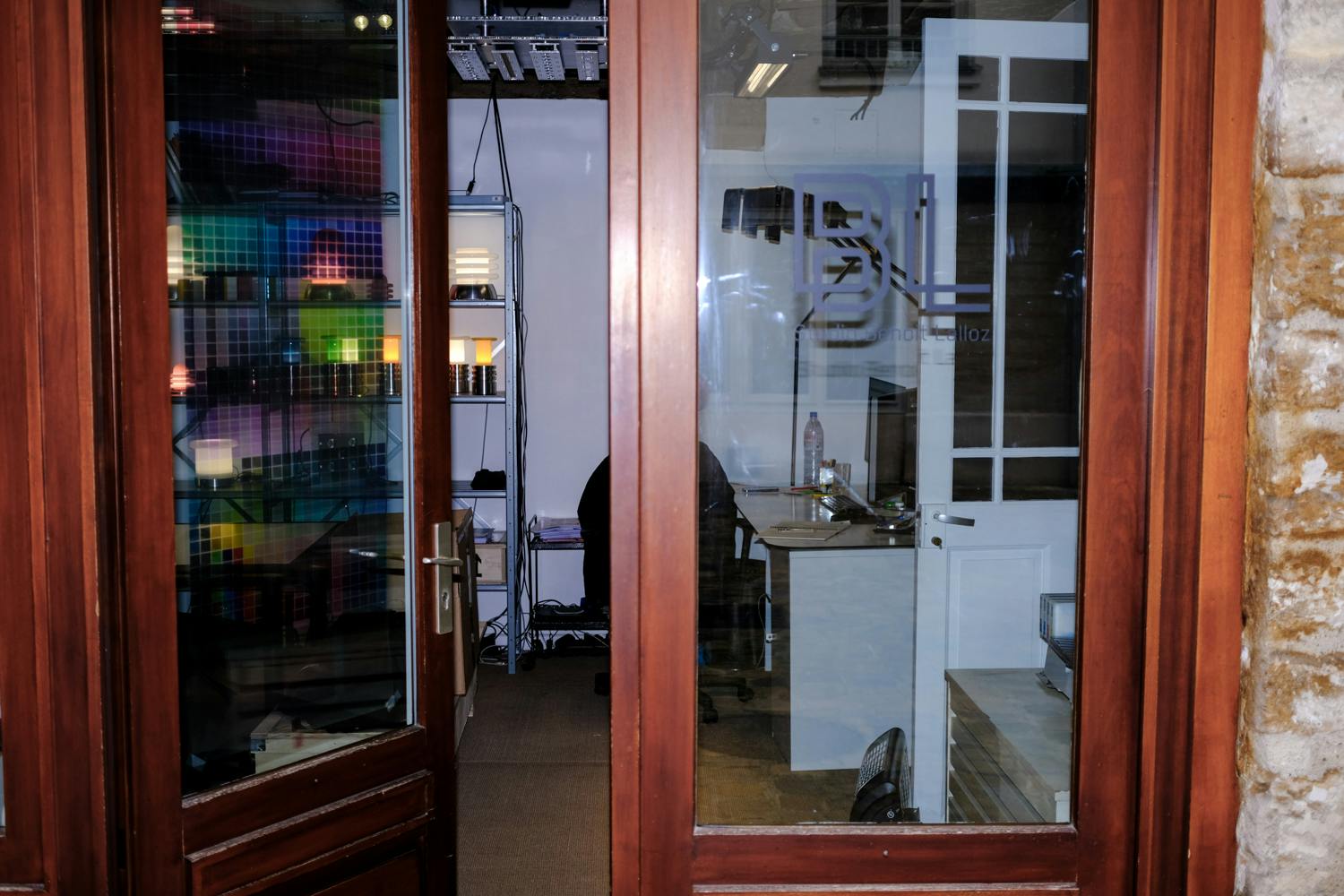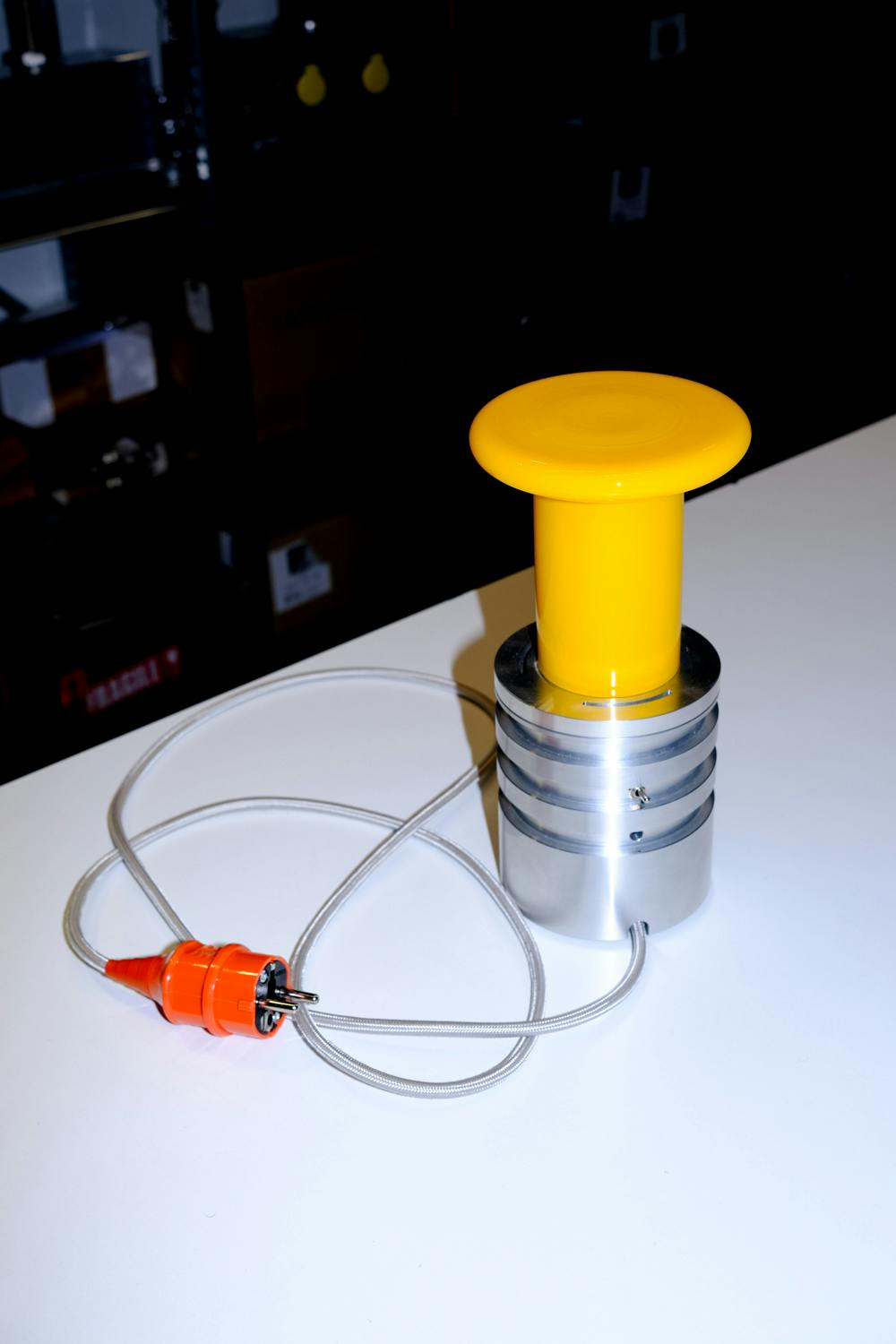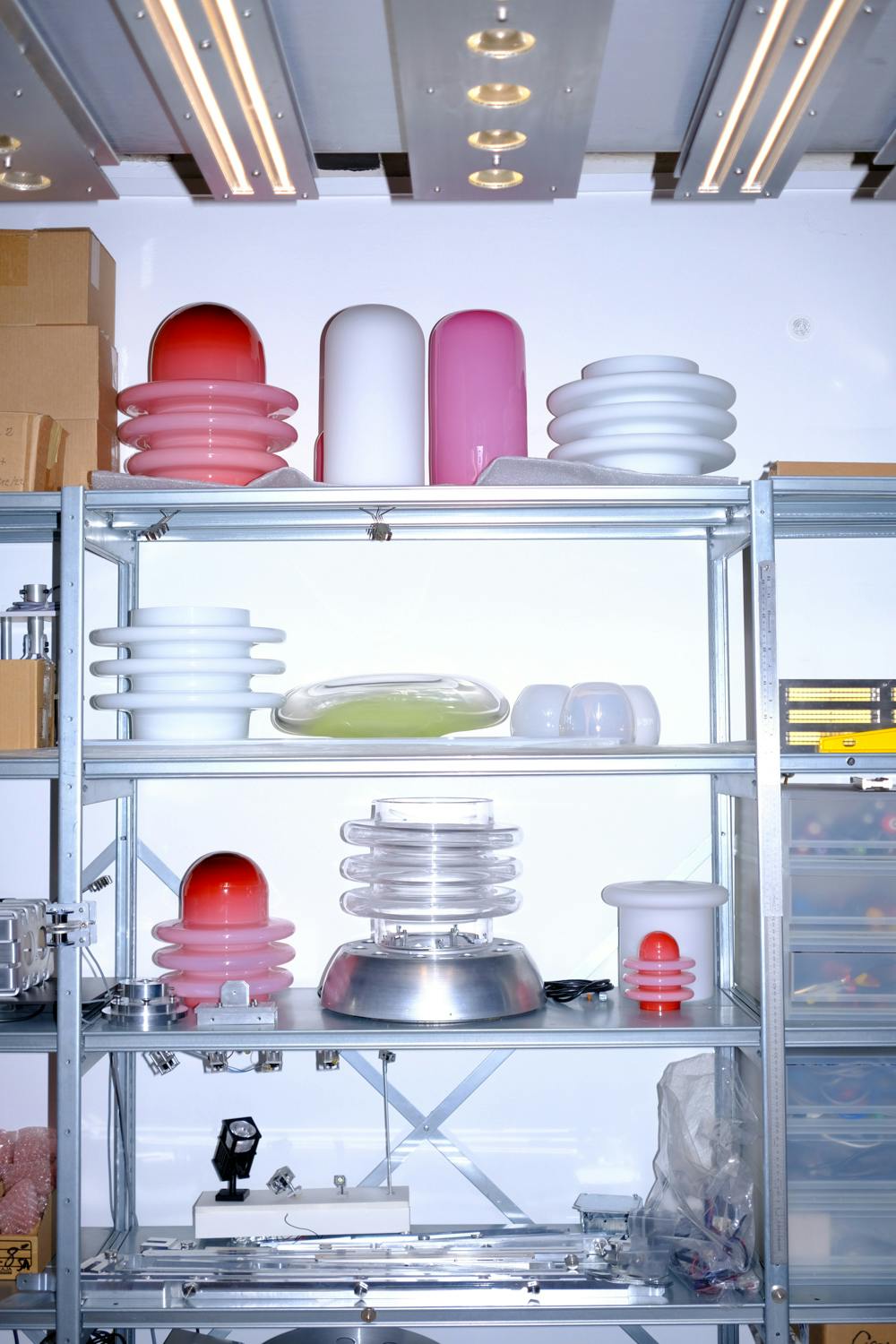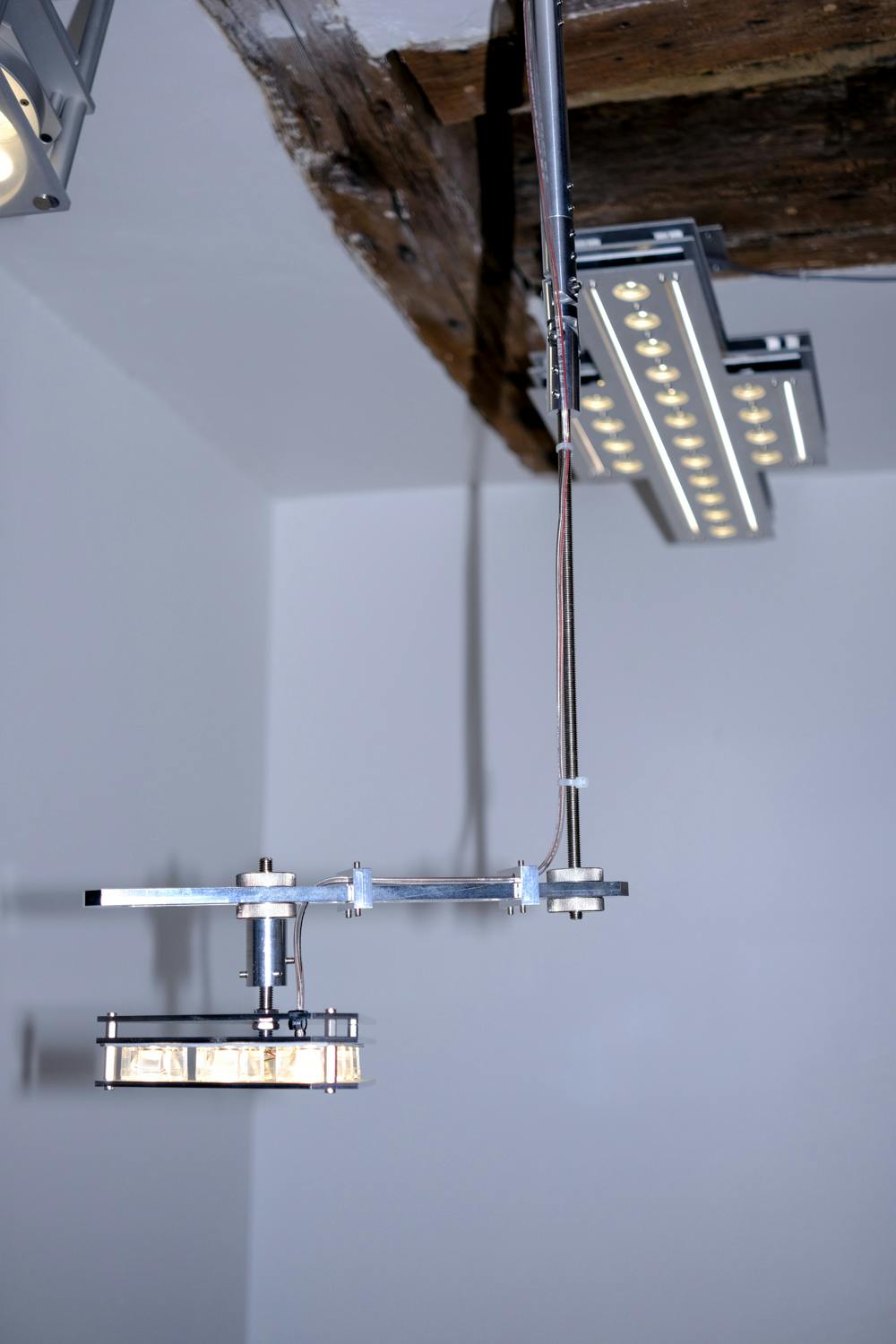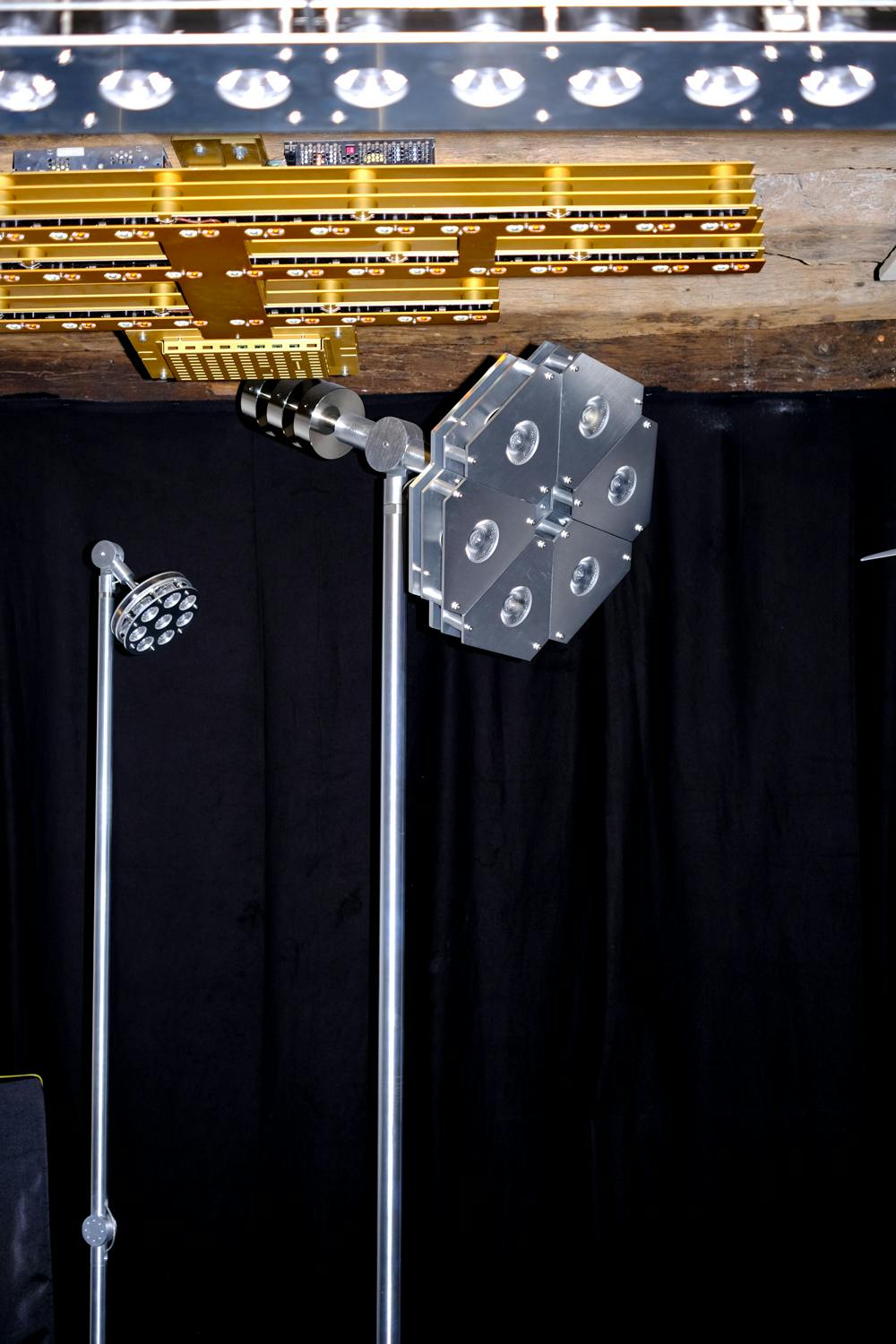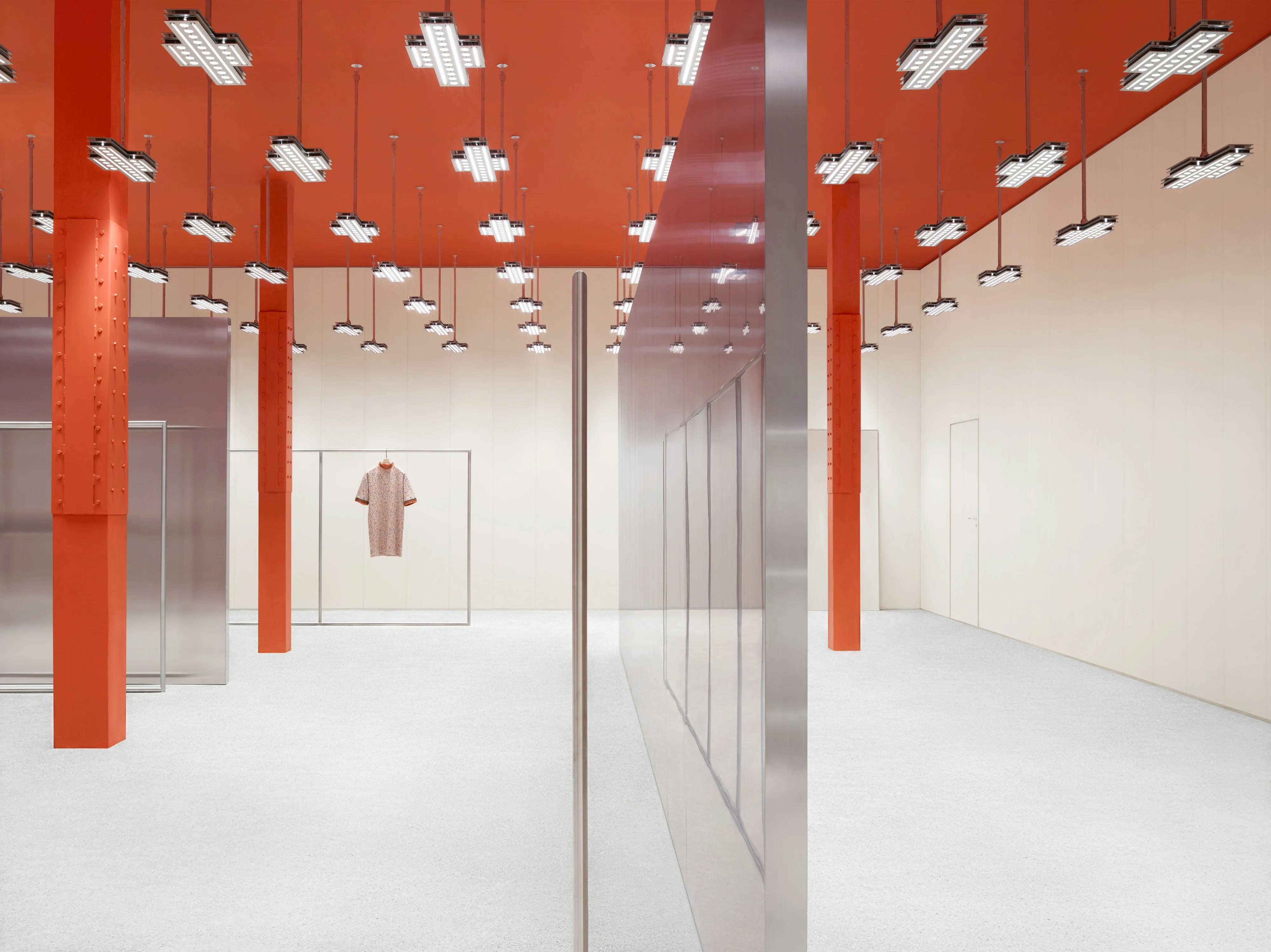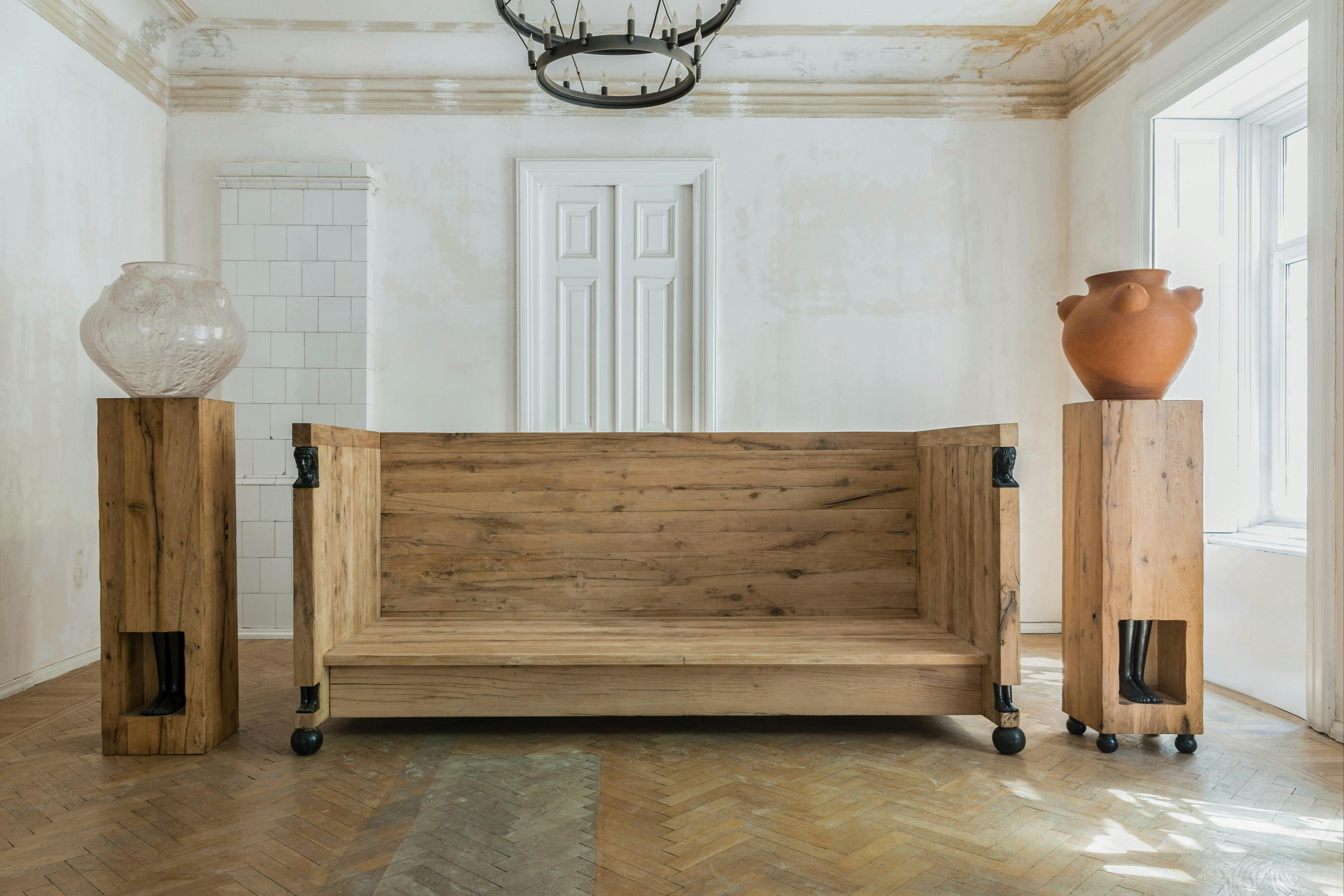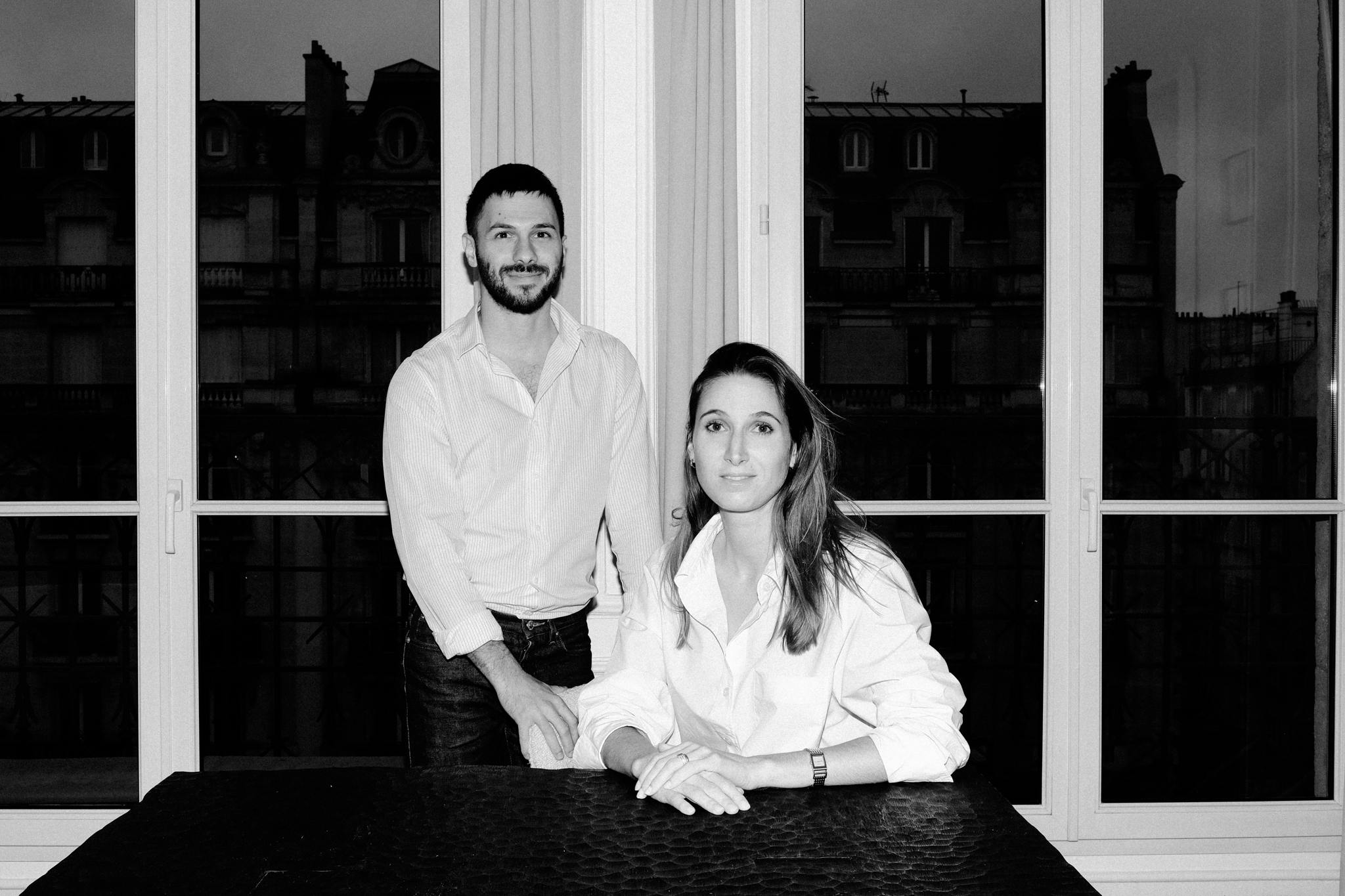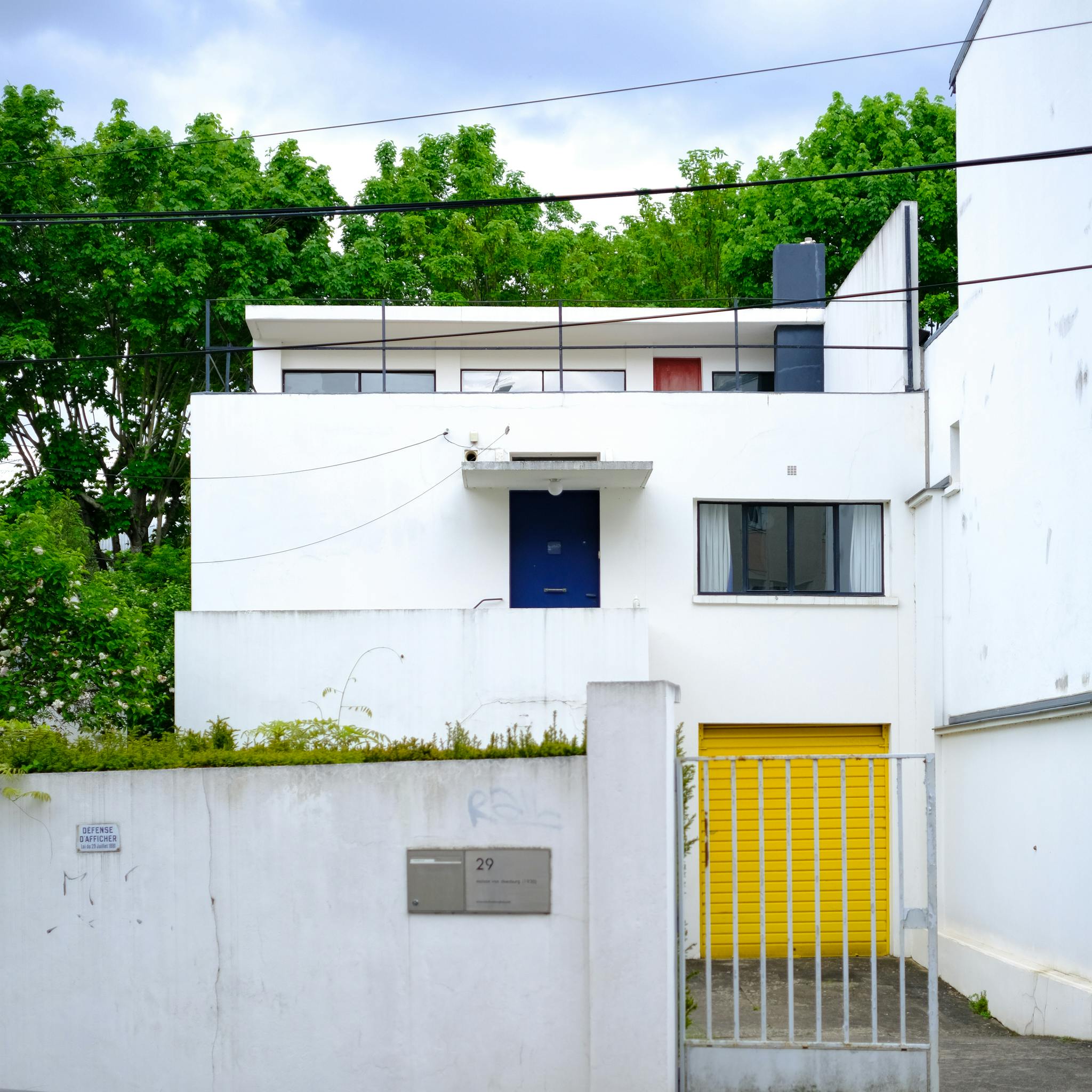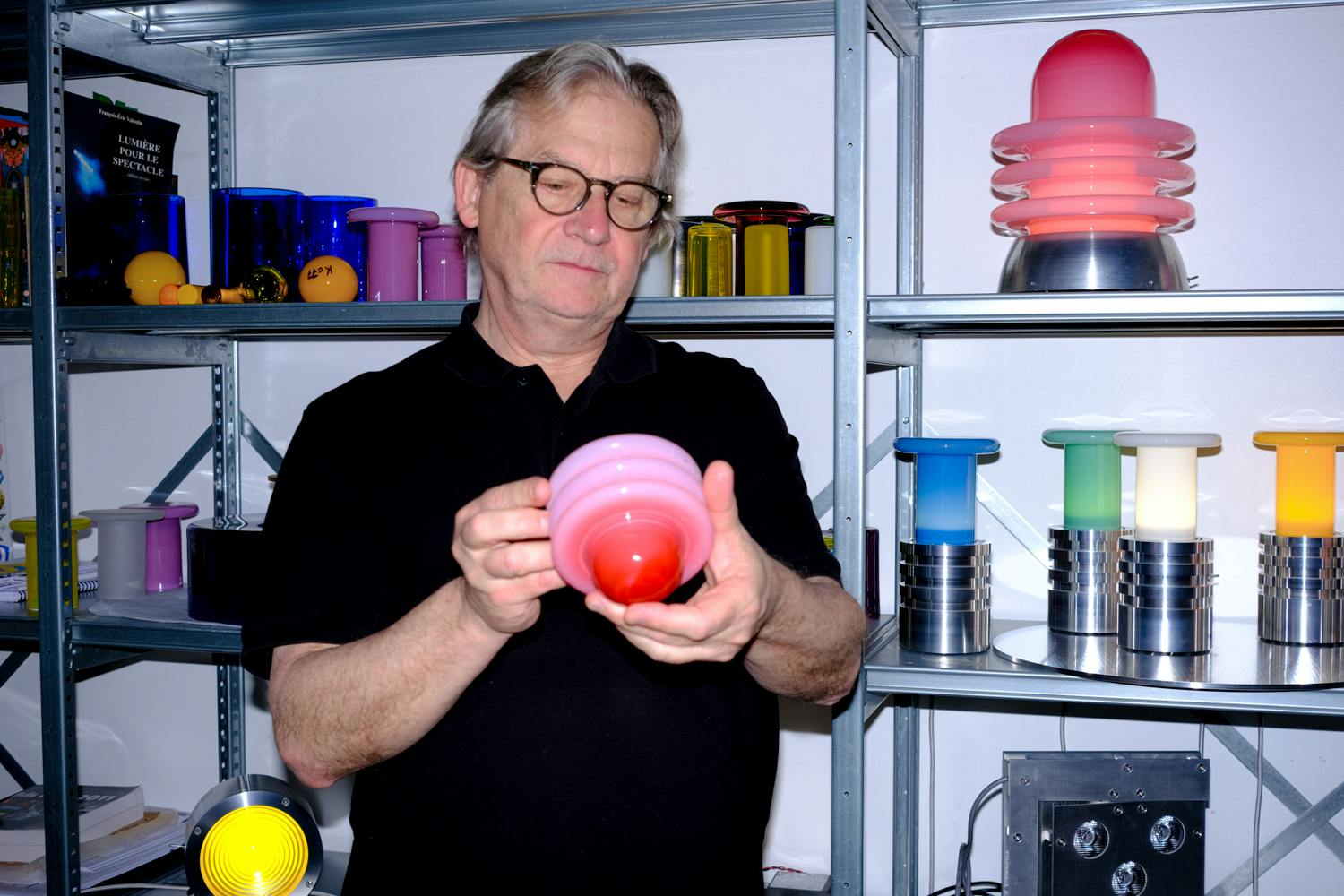
Studio Visit with Benoit Lalloz
We do a studio visit in Paris, France, with Lighting Artist Benoit Lalloz
As harmonious as the spaces may be, anytime I walked into an Acne Store, I couldn't help but ask myself – but who did the lights? Well-known within Paris' fashion architecture circles, the answer is: Benoit Lalloz. Paris' most famed Lighting Designer you never heard of.
Time seemed to stop when sipping coffee with Benoit and his studio manager, Pauline, in their atelier in Paris' 11th arrondissement. Benoit's pure, authentic excitement and passion for what he was doing, for the things that interested him, the details he notices around him had a contagious effect. His humility in highlighting and emphasising the value of his team, each one by one, and how there could be no "Benoit Lalloz Studio" without them – reminded me why I am in this industry. How lucky I am to have this privilege. There are some real gems out there who are producing truly unique work for all the right reasons and with a lot of heart.
Childhood experiences watching Calder's Circus stirred a fascination with movement and animation, adolescent years at his high school's Cinema Club, engrossed in black and white films, bred his sensitivity to monochrome and contrast, and tinkering with watches and small electronics led to a certain understanding in the mechanics of objects. The rest is a serendipitous series of events from a chance invitation to write an article on lighting (before he ever designed a thing) to designing lights for the Paris Metro and later Balenciaga, Céline, Acne Studios... Several decades into this career, his exponential momentum only seems to be smoothly sliding into a crescendo.
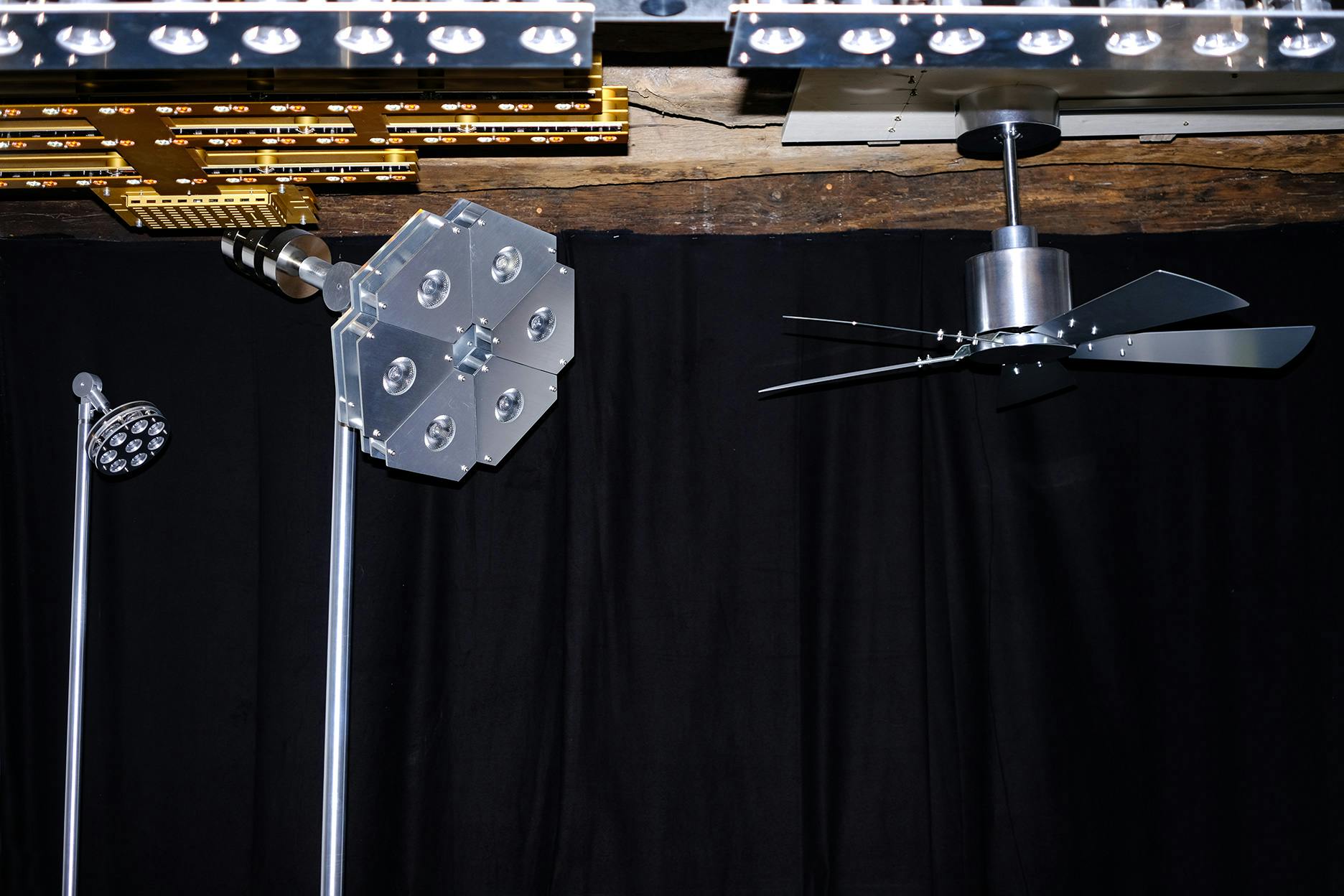
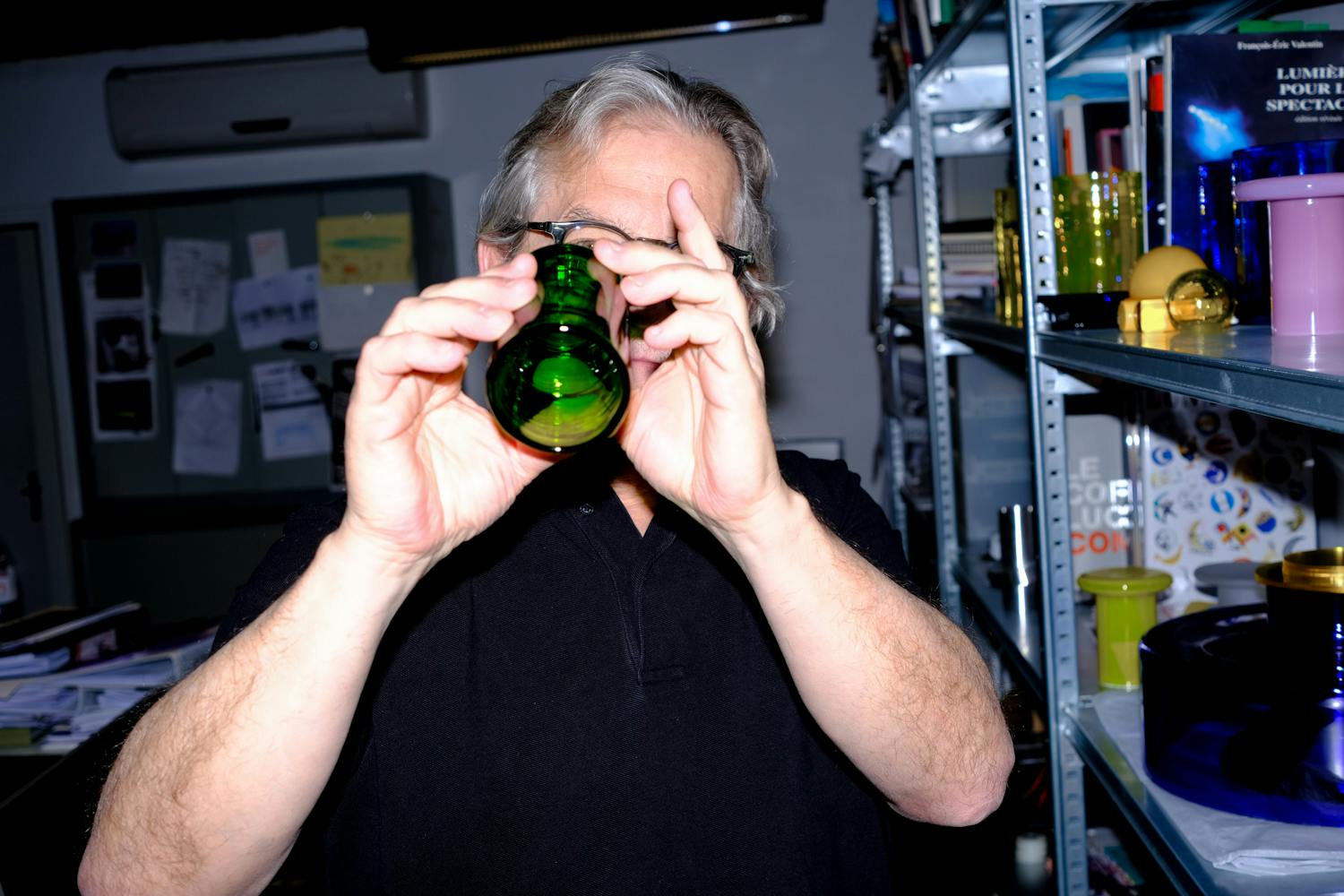
Kristen_ I am very interested in how our different experiences, our “past lives” influence our work. Can you tell us a little about some of the experiences that have informed your work today?
Je suis très intéressée par la manière dont nos différentes expériences, nos « vies antérieures » influencent notre travail. Pouvez-vous nous parler un peu de certaines des expériences qui ont éclairé votre travail aujourd’hui ?
Benoit_ I had my first experience with lighting at fourteen when I was at boarding school. I loved the Movie and Photography Clubs at school, they were run by a former colleague of Henri Langlois at the Cinémathèque Française. At that time, in 1974, black and white was still very much a thing. I would say that this incredible experience enabled me to develop a great sensitivity to monochrome, to the powerful effects of light and its contrasts.
I also have a strong relationship with the circus, with movement and animation, because the film 'Calder's Circus' I had seen as a child had left a lasting mark on my imagination.
All the memories came flashing back to me when we were contacted by the team behind Luna Luna. It's an incredible story that takes place in 1987 in Hamburg. The artist André Heller asked several artists, including Sonia Delaunay, Basquiat, Dali and Keith Harring, to create a fun fair to spread culture with contemporary works. The amusement park went bankrupt after a year and everything was bought by collectors and left in containers to be stored in Texas. The artistic director, Michael Goldberg, mentioned it to Drake, who was immediately taken by the idea and bought up the entire collection. They contacted us before the summer to work on a set design, but the collaboration didn't come to fruition at the time. Despite that, thanks to our discussions and this leap into my memory, I was greatly inspired to design a new lamp.
Benoit_ J’ai vécu mes premières expériences lumières vers l’âge de 14 ans quand j’étais en internat. Je me suis passionné pour le Ciné Club et le Club Photo du collège, animé par un ancien collaborateur d’Henri Langlois à la cinémathèque française. A l’époque en 1974, le noir et blanc était encore très présent. Je dirai que cette expérience incroyable m’a permis de développer une grande sensibilité au monochrome, c’est-à-dire à la puissance des effets de la lumière et de ses contrastes.
J’ai aussi une relation très forte avec le cirque, le mouvement et l'animation car enfant j'avais vu le film le ‘Cirque de Calder’ et c’est resté dans mon imaginaire.
Ce souvenir m’est revenu lorsque nous avons été contactés par les équipes de Luna Luna. C'est une histoire incroyable qui se passe en 1987 à Hambourg. L’artiste André Heller sollicite plusieurs artistes dont Sonia Delaunay, Basquiat, Dali, Keith Haring, pour créer une fête foraine et diffuser la culture avec des œuvres contemporaines. Le parc d'attractions fait faillite après un an et tout est racheté par des collectionneurs et part dans des containers pour être stocké au Texas. Et puis le directeur artistique Michael Goldberg en parle à Drake, qui a un immense coup de cœur et rachète toute la collection. Ils nous avaient contactés avant l'été dernier pour travailler sur une scénographie mais la collaboration avec eux n’avait pas abouti sur le moment. Malgré cela, nos échanges, et ce saut dans ma mémoire m’ont grandement inspiré pour dessiner une nouvelle lampe.
Is this your second launch?
C’est la deuxième lampe que vous lancez ?
B_ This is the third model we've designed, but it hasn't been released yet. It's reminiscent of what I did when I was making puppets. I would have loved to dance. I'm as stiff as a board, but movement has always interested me. There’s always a lot of movement in puppetry. This is something that comes out very often in my lighting work; it's a bit of a common thread.
B_ C’est le troisième modèle que nous dessinons, mais elle n’est pas encore sortie. Ce sont des réminiscences de ce que j'ai pu faire à l'époque où je faisais des marionnettes. J'aurais aimé faire de la danse. Je suis raide comme un bâton, mais le mouvement est quelque chose qui m'a toujours intéressé. Dans les marionnettes, il y avait beaucoup de mouvement et il y a très souvent du mouvement dans mon travail de lumière, c’est un peu un fil conducteur.
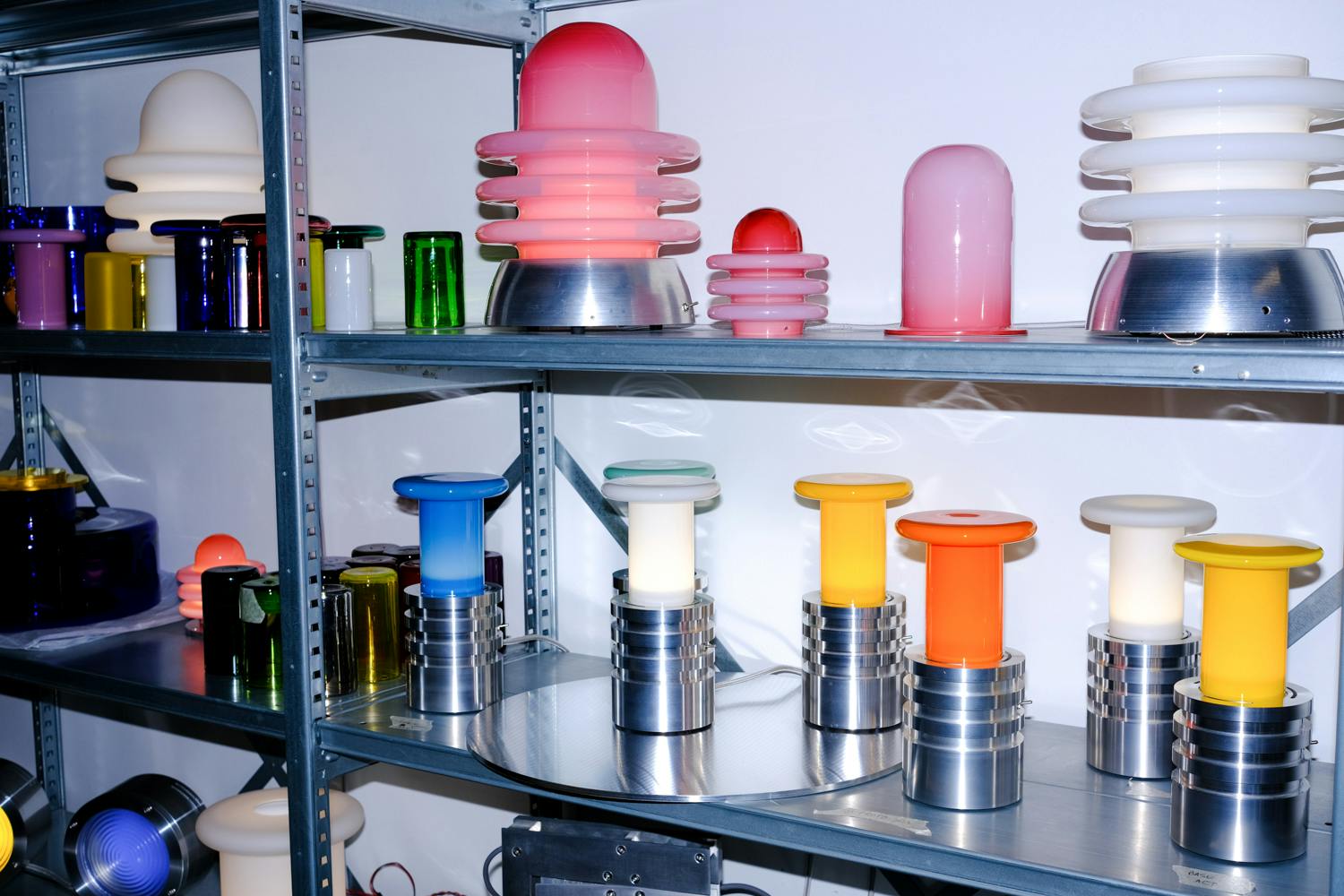
There’salwaysalotofmovementinpuppetry.Thisissomethingthatcomesoutveryofteninmylightingwork;it'sabitofacommonthread.
Benoit Lalloz
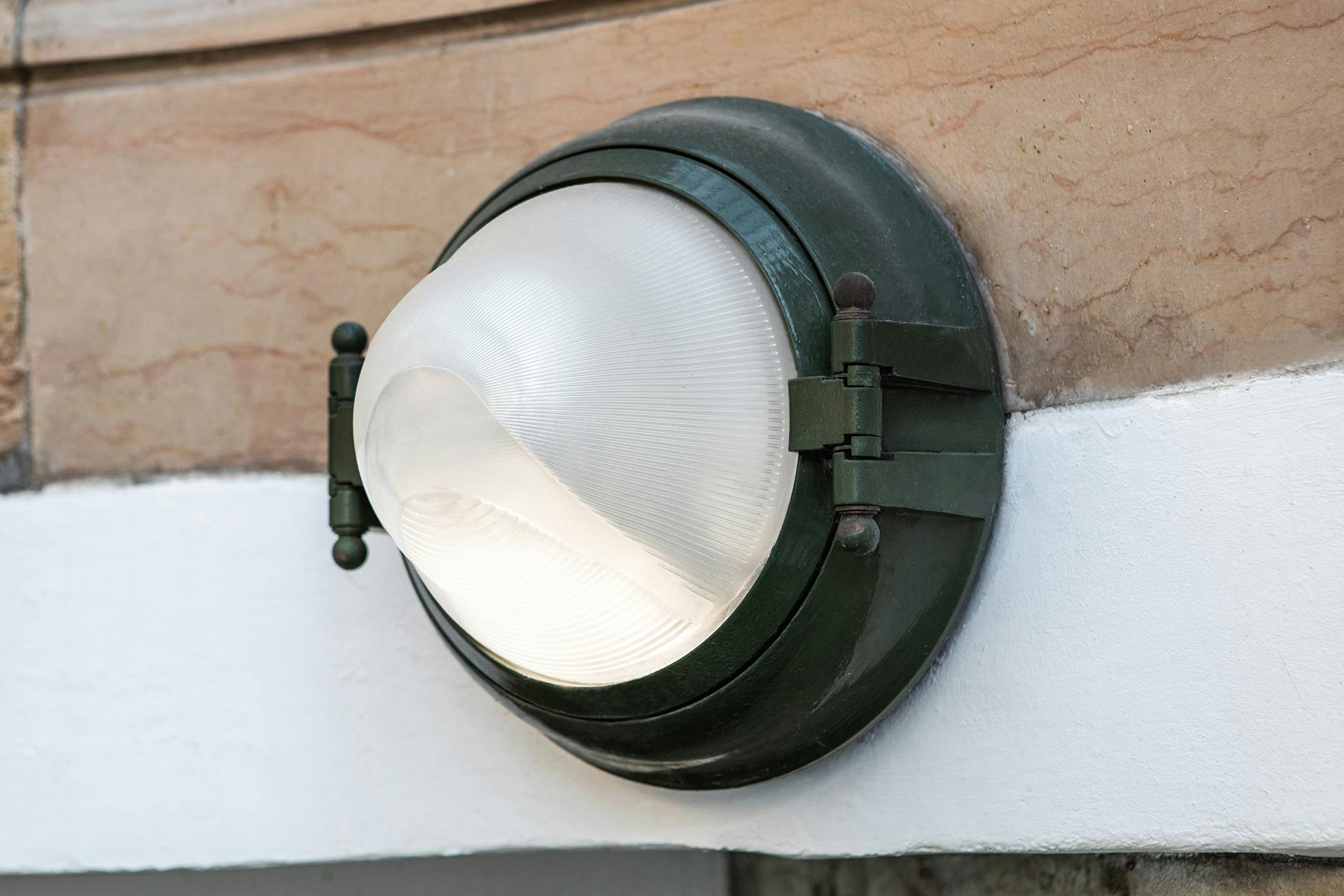
I noticed that [inspiration derived from puppetry] as I did some research on your work and the first time I saw your work in an Acne store. How did you first get your start in lighting design? I heard it was working with RATP [Paris Metro].
Oui, j'avais remarqué cela en faisant des recherches sur votre travail, notamment la première fois que j’ai vu votre travail dans un magasin Acne.
B_ That’s going back to a period of my life where I’m working a lot but I’m not earning much. And one evening at a friend's house, I was discussing lighting with the owner of a press review. From there, she asked me to write an article for the French Art & Decoration magazine. Then someone from the Paris public transport system, the RATP, who had read the article, placed an order for a first light fixture, which was a huge insect. This project never came to fruition, but little by little, I began to design lighting fixtures for the RATP.
B_ C'est une période de ma vie où je travaille beaucoup mais je ne gagne rien du tout. Et un soir chez des amis, je discute lumières avec la patronne d'une revue de presse. De là, elle me demande d’écrire un article pour la revue Art & Décoration. Puis quelqu'un de la RATP qui a lu l'article me passe commande d’un premier luminaire qui était un énorme insecte. Ce projet n'a jamais abouti, mais petit à petit, je me suis mis à dessiner des luminaires pour la RATP.
Was it the one for the Bonne Nouvelle metro station?
Oui, au métro Bonne Nouvelle.
B_ Yes, it was a station under the Rex [Club] on the theme of cinema. It lasted about a year. They took everything down because it required so much upkeep. There were screens on the platforms showing short films...There was a real cinema project.
Pauline_ In fact, there are also these lights which you see at the entrance of all the tube stops; these were designed by Benoit.
And it was the opportunity to meet Dominique Gonzalez-Foerster and Nicolas Ghesquière of Balenciaga. Dominique had a boutique project with a landscape theme and put forward an idea of natural, climatic light for this scenery that she had drawn with storms of warm and cold colours, variations of intensity, and false ceilings in opal luminous clouds. The idea was to recreate the impression of a sky in a store. It’s a concept that worked very well.
B_ C'était une station sous le Rex [Club] sur le thème du cinéma. Ça a duré un an à peu près. Ils ont tout démonté parce que ça nécessitait de la maintenance. Il y avait des écrans sur les quais avec des diffusions de courts métrages…Il y avait un vrai projet cinéma.
Pauline_ En fait, il y a aussi ces luminaires qui sont qui sont à l'entrée de tous les métros, qui sont restés dans toutes les stations de Paris qui ont été dessinées par Benoit.
Et ça a été l'occasion de rencontrer Dominique Gonzalez-Foerster et Nicolas Ghesquière de Balenciaga. Dominique avait un projet de boutique sur le thème du landscape (ndlr: paysage) et j'ai proposé une idée de lumière naturelle, climatique dans ce paysage qu'elle avait dessiné avec des tempêtes de couleurs chaudes et froides, des variations d'intensité; des faux plafonds en nuages lumineux opales. L’idée était de reconstituer l'impression d'un ciel dans une boutique. C’est un concept qui a marché très fort.
Is it still there?
Est-ce que c'est toujours là?
B_ No. It was Avenue George V in Paris. But also in New York, in Soho, there it was linked to the climate of space working around the clock. The moon and the sun passed through a trap of light. We did this in Paris, New York, Hong Kong and in a store in China too.
B_ Non. C'était Avenue George V. Mais aussi à New York, à Soho, là c’était lié au climat de l'espace avec une programmation de vingt-quatre heures. La lune et le soleil passaient par une trappe de lumière. On a fait ça à Paris, New York, Hong Kong et dans une boutique en Chine aussi.

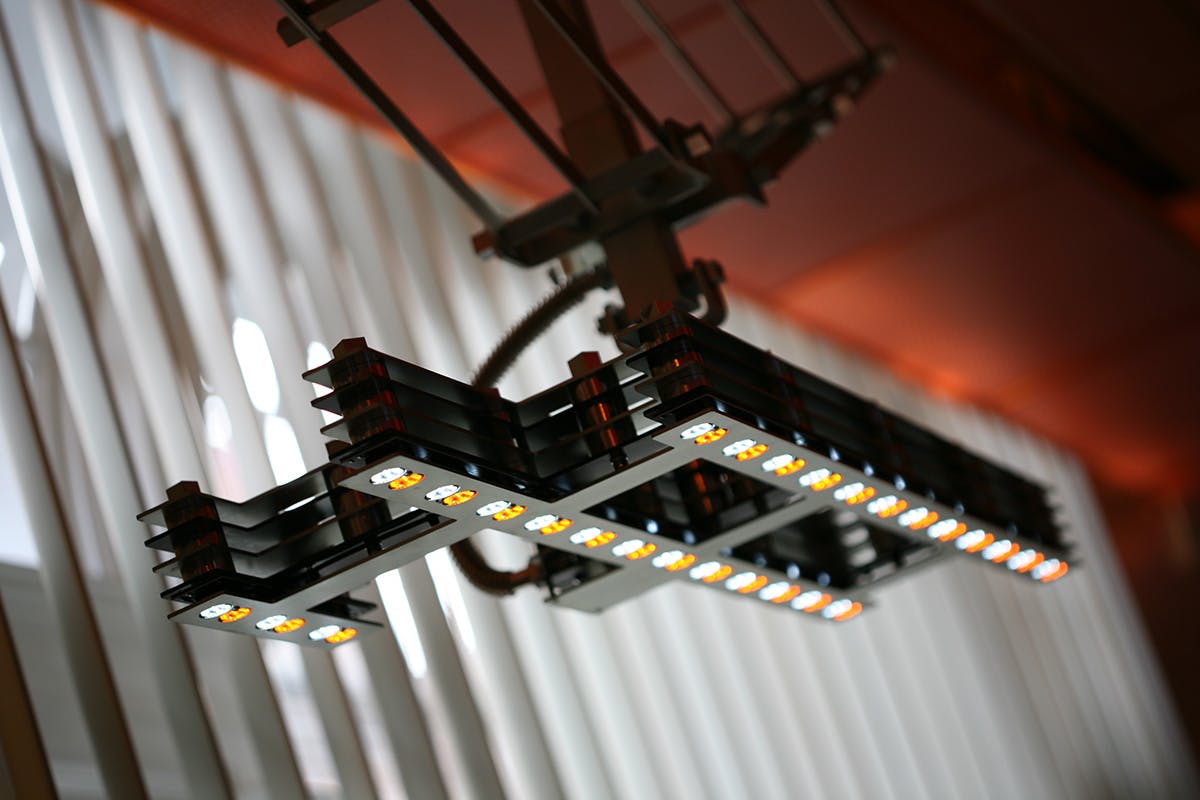
Did you have formal technical training? Something that would help convince people to support your ideas?
Avez-vous une formation technique ? Peut-être pour convaincre les gens de vous donner l'opportunité de réaliser vos idées ?
B_ It's a bit of a mystery because I didn't go on to study. I started working at nineteen. But I studied watchmaking a lot to make automations and that brought me into a culture with technical knowledge. As I furthered my experience, quite a few artists came to me with ideas that they didn't know how to bring to fruition. So I worked for several years developing their light works. Then I started working for myself.
I’ve never worked alone because I hate solitude and I like working in a team. So I would find subcontractors, specialised craftsmen who came to enrich everything we did. It’s all about making the right encounters. For example, there is a lighting company in France run by the son of a tractor mechanic, who is passionate about electronics. It is one of the most innovative companies in France for lighting today.
And then you find creative people who like to rack their brains a little to find solutions. If you take for example the satellite lighting fixture here. This lamp represents a radiator but also a small town. So this dates back to 2006, 2007 when I was working with Balenciaga. At the time it was necessary to cool the LEDs down because they emitted so much heat and I had developed a technique so that they didn't overheat...
B_ C'est un peu le mystère parce que je n'ai pas fait d'études. J'ai commencé à travailler à dix-neuf ans. Mais j'ai beaucoup étudié l'horlogerie pour faire des automates et ça m'a fait entrer dans une culture avec une connaissance technique. Et l'expérience aidant, pas mal d'artistes sont venus me voir avec des idées, qu’ils ne savaient pas faire aboutir. Donc j'ai travaillé plusieurs années à mettre au point leurs œuvres de lumière. Puis j'ai travaillé à mon compete.
Je n'ai jamais travaillé seul parce que je déteste la solitude et j'aime bien le travail en équipe. Et puis j'ai trouvé des sous-traitants, des gens spécialisés qui sont venus enrichir tout ce qu'on faisait. Ce sont des rencontres. Par exemple, nous travaillons avec une entreprise de lumières en France dirigée par un fils de mécanicien de tracteur, qui est passionné d’électronique. Et c'est une des entreprises les plus innovantes de France en lumière aujourd'hui.
Et puis il y a des gens qui aiment bien se creuser un peu le cerveau pour trouver des solutions. Si tu prends par exemple le luminaire satellite qui est ici. En fait, cette lampe est un radiateur mais aussi une petite ville. Donc là on est en 2006, 2007 pour Balenciaga. A l'époque il fallait refroidir les LEDs parce qu’elles chauffaient beaucoup et j'ai développé une technique pour que ça ne chauffe pas…
I thought this was just through the design.
Je pensais que cela était dû seulement au design.
B_ The design comes from a constraint. I realised that this shape was in fact a radiator.
B_ Le design vient d'une contrainte. Je me suis rendu compte que cette forme-là représentait un radiateur.
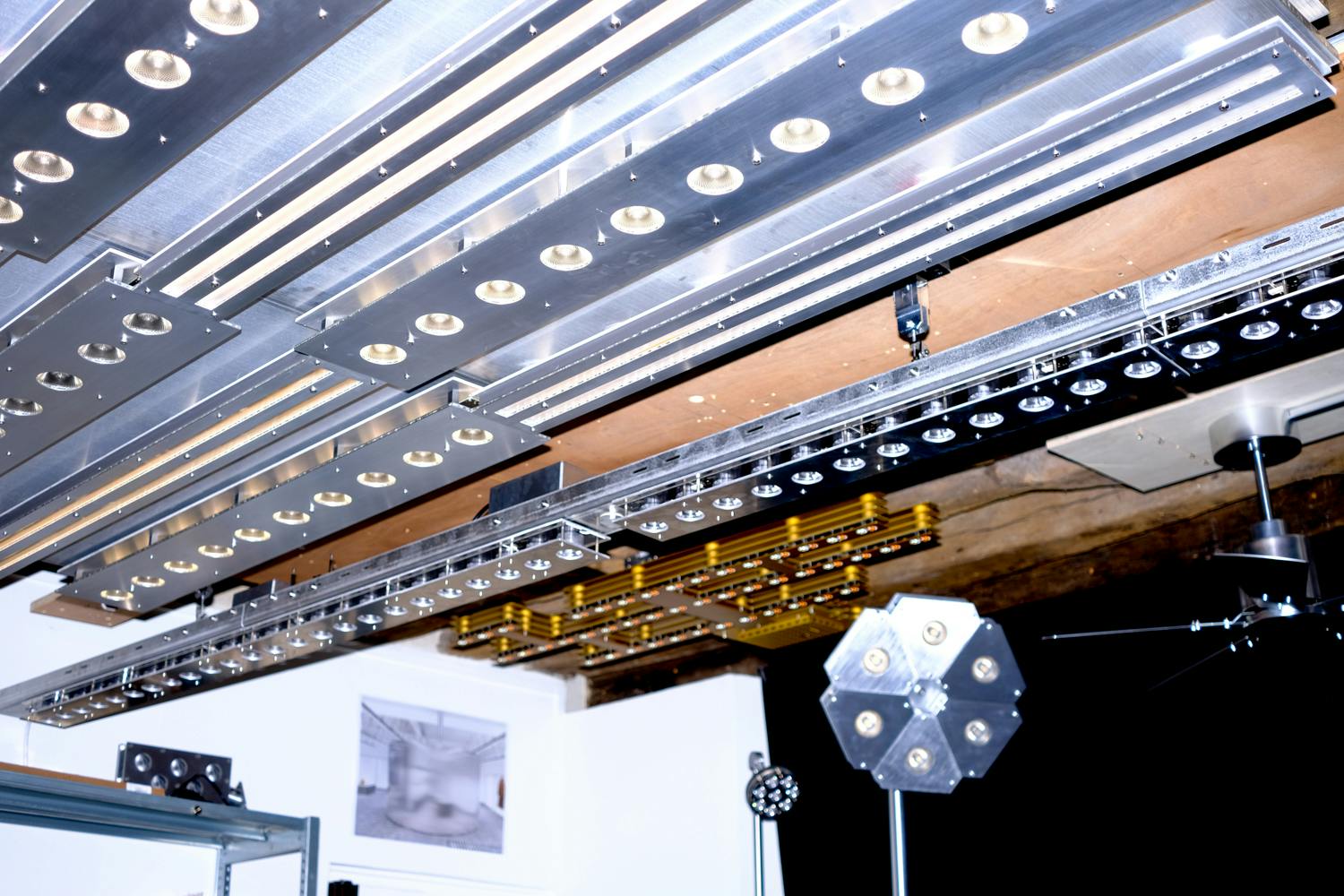
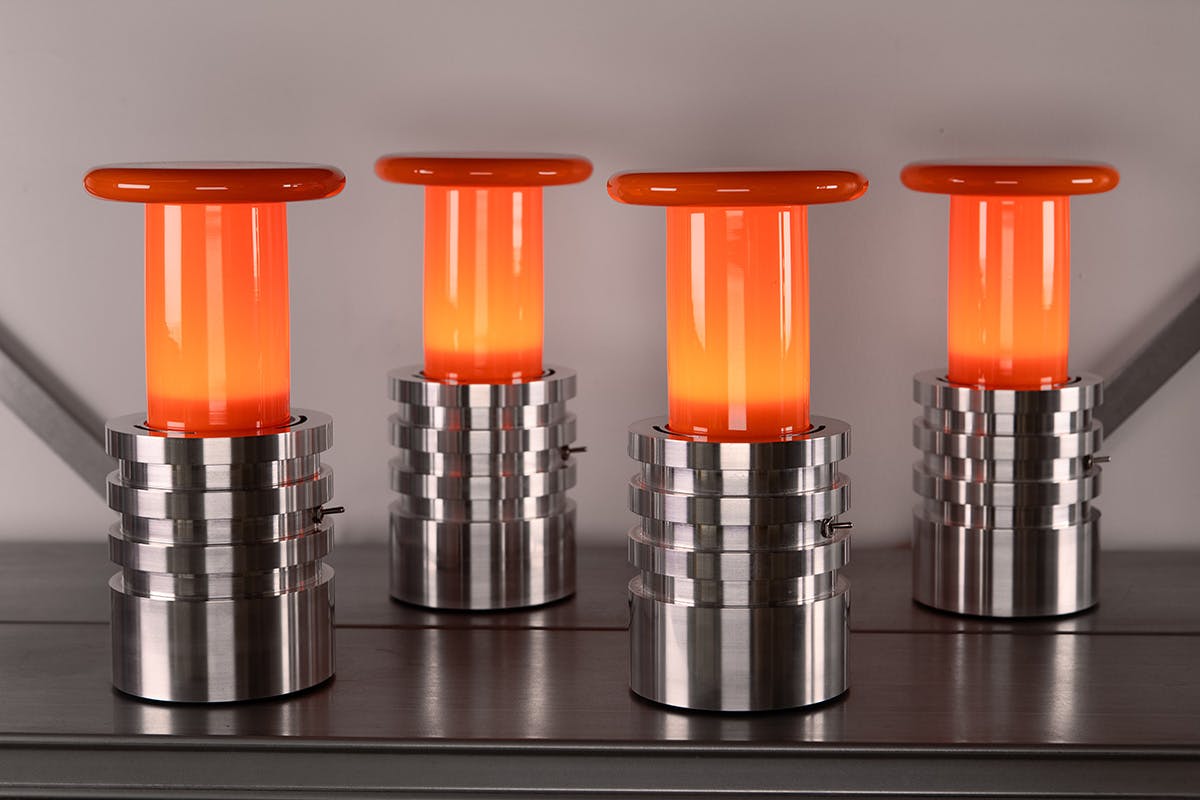
I am very interested in your work as an artist and engineer. I've never met anyone like you before.
Je suis très intéressée par votre travail d’artiste et d’ingénieur. Je n’avais jamais rencontré quelqu’un comme vous avant.
B_ It’s called Benoit Lalloz studio to underline that I don’t work alone. This is Pauline, she is an architect but also specialises in communication. She therefore brings her own culture to the team.
There is Hélène, who trained as a designer and worked for a long time in an LED lighting company, notably with these fixtures here. There is Bruno, who takes all the photo renderings of our projects for clients. And, there is Hugo, an obsessed and obsessive designer, a bit like me.
B_ C'est le studio Benoit Lalloz donc je ne travaille pas seul. Voici Pauline, elle est architecte et aussi spécialisée en communication. Elle apporte donc sa propre culture à l'équipe.
Il y a Hélène, qui a une formation de designer et a longtemps travaillé dans une société de luminaires à LED, notamment ces luminaires-là. Il y a Bruno, qui nous fait tous les rendus photo de nos projets pour les clients. Ensuite, il y a Hugo, un designer, obsédé et obsessionnel, un peu comme moi.
I noticed that too. At first glance, you might think that your work is minimalist, but on a second look, you realise that it is very complex and refined work.
J'ai effectivement remarqué cela. À première vue on peut penser que votre travail est minimaliste, mais quand vous regardez une deuxième, vous vous rendez compte que c’est un travail très complexe, très raffiné.
B_ We spend so much time working on each piece, you can’t imagine! For the small Mycelium lamp here at the gallery, we had tests done in Switzerland. They couldn't get the shape of the glass as I wanted it. It's blown glass. The shape is very simple, but it is very complicated to make this uniform ring to allow it to diffuse when it’s lit.
Then we tried with a Swedish blower, a very good blower in the Paris region but who didn't know how to be consistent with the colours. We ended up working with a young person that we discovered by chance. This means that instead of it taking three months, it took two years.
And that requires a lot of investment. And then we did lots of tests, with different colours for the blown glass depending on the temperature. It's tremendous work...but since the idea of this lamp is for it to provide this soul in the house, a radiance, something incredible, the goal is that people start to love the presence of the lamp, the light diffused by this luminous object.
B_ On passe un temps de travail, vous n’imaginez pas! Sur la petite lampe Mycélium qui est à la galerie, on a fait faire des tests en Suisse. Ils n'arrivaient pas à sortir la forme de la verrine comme je voulais. C'est du verre soufflé. La forme est très simple, mais c’est très compliqué pour arriver à faire cet anneau de manière uniforme, que ce soit diffus quand il est éclairé.
Puis on a travaillé avec un souffleur suédois, un très bon souffleur en région parisienne mais qui ne savait pas comment répéter les couleurs. Et en fait, on a fini par travailler avec un jeune qu'on a découvert par hasard. Ça veut dire qu'au lieu que ça prenne trois mois, ça a pris deux ans.
Et ça peut demander beaucoup d'investissements. Et puis on a fait plein d'essais, de couleurs différentes pour le verre soufflé en fonction de la température. C’est un travail horrible…mais comme l'idée de cette lampe, c'est vraiment une âme à la maison, un rayonnement, quelque chose d'incroyable, le but c’est que les gens se mettent à aimer la présence de la lampe, de la lumière diffusée par cet objet lumineux.
You said that at the beginning you were very poor. When I started say hi to_, I was also struggling to pay the rent. My landlord knew I sold art and from time to time he would buy some from me so I could pay the rent. How did you manage when you first started so as not to have to make compromises? Because I feel that you have a strong vision and that you do not compromise.
Vous avez dit qu’au début vous étiez très pauvre. Quand j'ai commencé Say Hi to, j’avais aussi du mal à payer le loyer. Mon propriétaire savait que je vendais de l’art et de temps en temps il m’en achetait pour que je puisse payer le loyer. Comment avez-vous fait à vos débuts pour ne pas avoir à faire de compromis? Car je sens que vous avez une vision forte et que vous ne faites pas de compromis.
B_ This is the only way to survive. If I compromised, the banality of my work would immediately be in competition with so many other projects...if you search for lighting fixtures online, you get hundreds of thousands of photos. If I accept compromise, my competition becomes the whole world.
B_ C'est la seule manière de survivre. Si je fais des compromis, immédiatement, la banalité du travail que je vais faire va être en concurrence…si vous tapez luminaires sur internet, vous avez des centaines de milliers de photos. Si j'accepte le compromis, je suis en concurrence avec la terre entière.
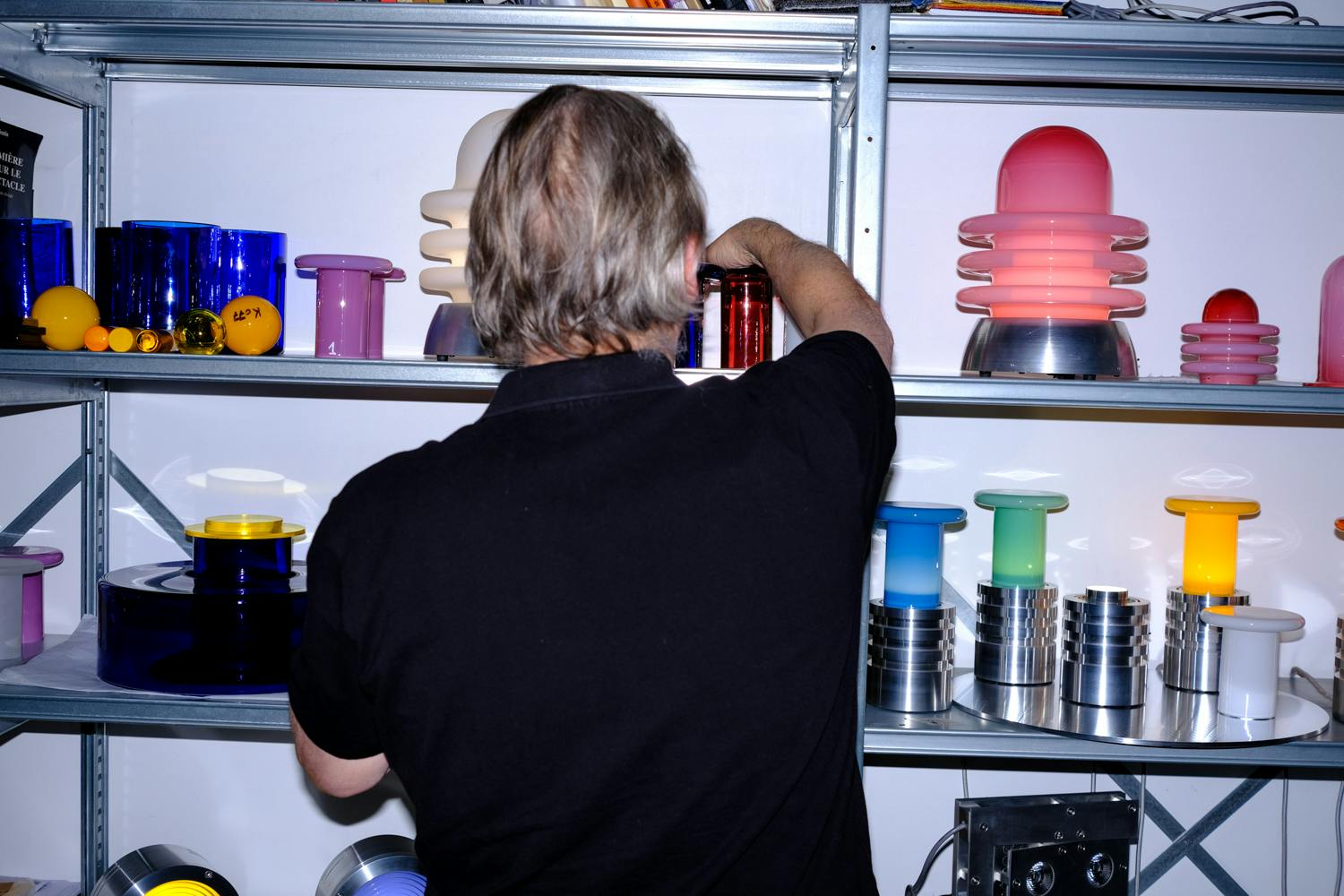
What you say is very inspiring and important. However, I have the impression that it is very difficult and complex to copy your work.
C'est très inspirant et important ce que vous dites. Pour autant j’ai l’impression que c’est très difficile et complexe de copier votre travail.
B_ Not at all, it's very simple. Some people copy it exactly.
Pauline_ But we’re talking counterfeiting here, not simply drawing on it for inspiration.
B_ Mais non, c'est très simple. Il y a des gens qui copient exactement pareil.
Pauline_ Mais là il s’agit de contrefaçon, pas d’inspiration.
Are you talking about counterfeiting on an industrial scale?
Vous parlez de contrefaçon à l’échelle industrielle ?
B_ Yes, you can’t imagine how terrible it is.
B_ C’est épouvantable.
How do you deal with that?
Comment faites-vous face à ça?
B_ There’s nothing you can do. A company presented a 200-m2 stand at a retail trade show in China. If it were my stand, it would have been the same.
P_ They picked up the photos of the stores we worked on on our site and copied it all. There are eight fixtures they copied all together.
B_ On ne peut rien y faire. En Chine, Il y a une entreprise qui présente un stand peut être de deux cents mètres carrés, à tous les retail markets. Si c'était mon stand, ça serait le même.
P_ Ils ont pris des photos des boutiques sur notre site et ils ont tout refait pareil. Il y a huit luminaires copiés.
What do you do when that happens?
Que faites-vous quand ça arrive?
B_ We’re helpless.
B_ On ne peut rien faire.
How do you manage your emotions?
Comment gérez-vous vos émotions par rapport à ça?
P_ They don't have the same attention to detail, to finishes, there are inevitably differences.
B_ It's very annoying, very frustrating. But take this example, the RATP ordered a light fixture from me for the Saint-Denis Grand Stade station. I signed over the rights, this was a time when I was poor and needed the work. They bought this light fixture for close to nothing and they covered thousands of square metres of underground with it. The rules of business exist for a reason. But obviously, life isn’t just about that. Culture is important. Humanity is important, but you can’t ignore the rules of business, especially now in a world where international business is fierce. So yes, they copy what I do. What do you want me to do about it?
P_ Ils n’ont pas le même souci du détail, des finitions, il y a forcément des différences.
B_ C'est très rageant, très frustrant. La RATP m’avait commandé un luminaire pour une station, Saint-Denis Grand Stade. J'ai cédé les droits à l'époque où j'étais pauvre et je voulais absolument travailler. Ils ont acheté ce luminaire pour rien du tout et ils ont fait des milliers de mètres carrés dans le métro avec. Les règles du commerce, ça ne s'invente pas. Mais il n'y a pas que ça. La culture, c'est important. L'humanité, c'est important, mais les règles du commerce, il faut les apprendre surtout maintenant qu'on est dans un monde où le commerce est violent. Après ça on me copie. Qu'est ce que vous voulez que j’y fasse?
But don’t you have patents?
Mais est-ce que vous avez des brevets?
B_ Yes, but they’re no use. If I am copied in China, I’d have to hire a lawyer in France, who will hire a lawyer in China who will have to agree to sue the Chinese company. It’s all very complicated and expensive. And then if you take this company to court, that company will disappear and another one will appear in its place. So now I no longer file patents for designs. I register them through Soleau envelopes so that no one can stop me from carrying out my designs. But I do very few drawings. I worked on a showroom for a brand. I designed a new system of hanging bars for them. They copied it in all their stores around the world. They made a whole concept out of it. That's what's crazy. What do you want me to do?
B_ Oui, mais ça ne sert à rien. Là je suis copié en Chine. Il faudrait que je prenne un avocat en France, qui va prendre un avocat en Chine qui va devoir accepter de lutter contre une entreprise chinoise et ça, c'est très compliqué et très cher. Et puis si cette société vous la mettez au tribunal, elle va disparaître et c'est une autre qui va apparaître. Donc maintenant je ne dépose plus de dessins et modèles. J'essaie de faire des enveloppes Soleau pour qu'on ne m'interdise pas de faire ce que je fais. Mais je fais très peu de dessins. J'avais travaillé avec une marque pour leur showroom où je leur ai dessiné un nouveau système de ‘hanging bars’. Ils en ont fait leur concept et ont copié ça dans toutes leurs boutiques. C'est ça qui est fou. Qu'est ce que vous voulez que je fasse?
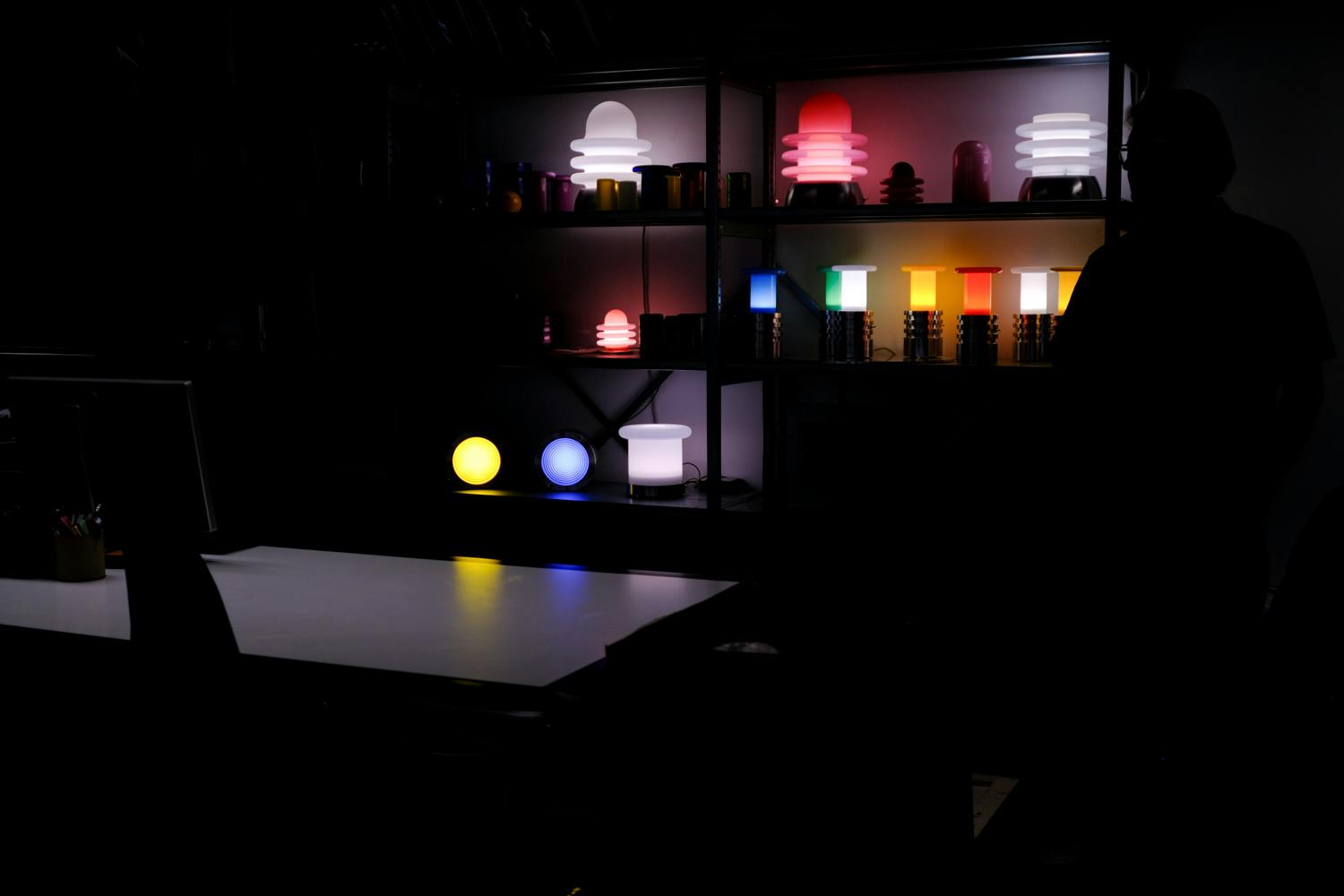
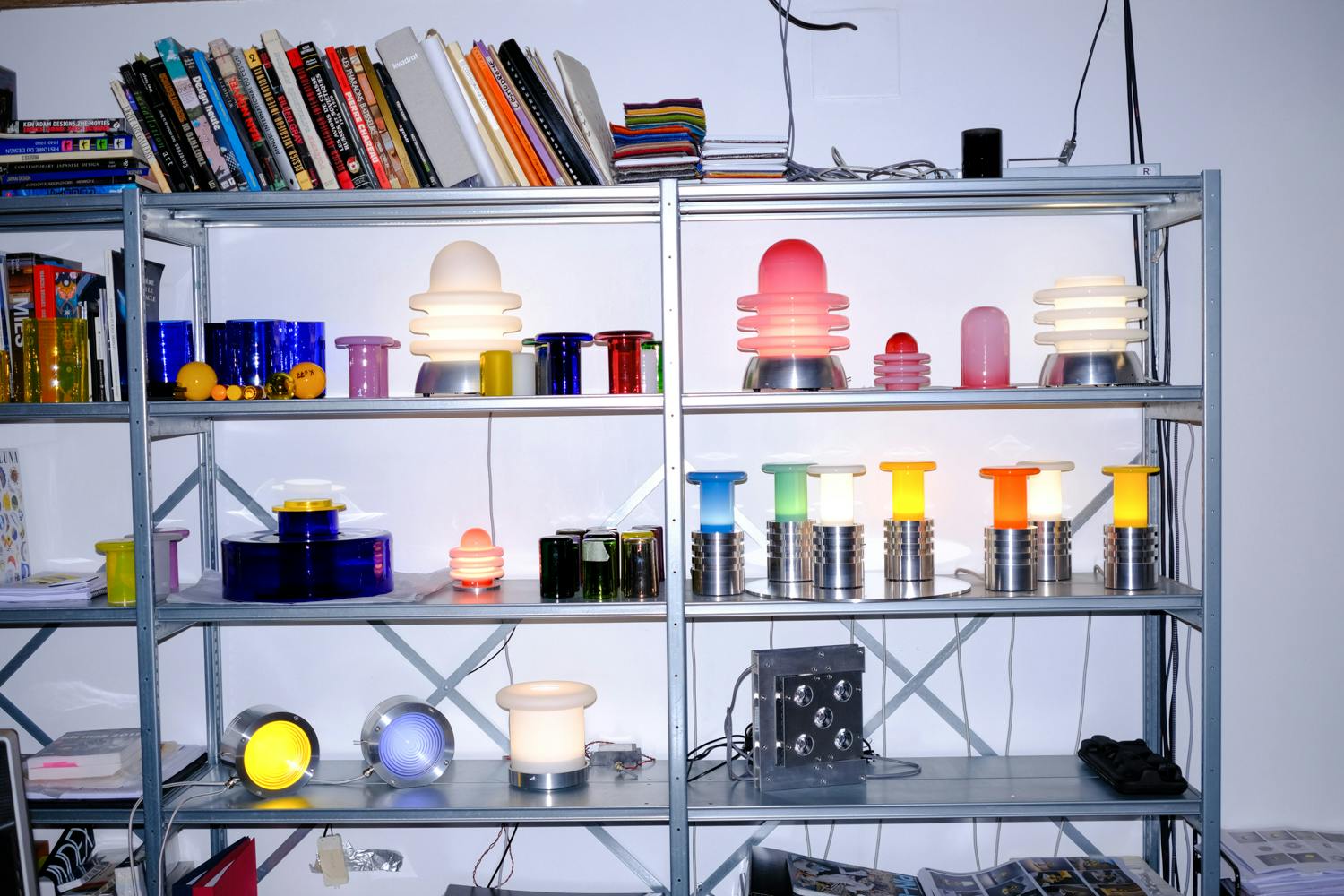
I had a question about your inspirations as we are both big fans of Wim Wenders. Have you seen his latest film, Perfect Days? And how does cinema influence your work?
J'avais une question au sujet de vos inspirations car nous sommes tous les deux de grands fans de Wim Wenders. Avez-vous vu son dernier film, Perfect Days? Et comment le cinéma influence-t-il votre travail?
B_ Yes, Wim Wenders, it's both his aesthetic that amazes me, but also all his location work for his films, because he has an amazing collection of photos, especially for his research for the filming of 'Paris, Texas'. I saw an exhibition, I think in Madrid or Valencia with photos of his research for ‘Paris, Texas’. His photographic work is incredible. So I don't know if I'm pinching his ideas, I see it more as a visual enrichment, drawing on the idea that completely unexpected things and opposites can co-exist.
Some things have guided my work for a long time. Earlier, we were talking about banality. I went through fourteen or fifteen different schools because I was a very turbulent child. I realised that I could find my identity by doing the opposite of what others were doing, and I think that that was a driving force for me. Having said that, you can't always make everything yourself. We feed on others and with someone like Wim Wenders, there is such a poetic force in his work that it pushes me to read poetry, to think about poetry. And that brings me mental images.
B_ Oui, Wim Wenders, c'est à la fois son esthétique qui me sidère, mais aussi tout son travail de repérage pour ses films, parce qu'il a des collections de photos qui sont complètement dingues, de ses recherches pour les tournages de ‘Paris, Texas’. J'ai vu une exposition, je crois à Madrid ou à Valence avec des photos de ses recherches pour ‘Paris, Texas’. C’est incroyable son travail photographique. Alors je ne sais pas si je lui pique des idées, mais c'est plutôt un enrichissement visuel, de dire que des choses complètement inattendues, opposées peuvent exister.
Il y a des choses qui ont longtemps guidé mon travail. Tout à l'heure, on parlait de la banalité. J'ai fait quatorze ou quinze écoles, collèges différents parce que j'étais très turbulent. Je me suis rendu compte qu'en faisant l'opposé de ce que faisaient les autres, je trouvais mon identité et je pense que ça a été vraiment un moteur pour moi. Alors après ça, on ne peut pas tout inventer. On se nourrit de choses et quelqu'un comme Wim Wenders, il y a une telle force poétique dans son travail que ça me pousse à lire de la poésie, à réfléchir à de la poésie. Et ça, ça m'amène des images mentales en fait.
I’m also a bit of a nerd when it comes to cinema, I collect rare books and so on. I also find that Wim Wenders' films are very poetic, especially 'Perfect Days'. But I tend to work more alone, I travel to the middle of nowhere in Japan and explore everywhere. That’s why I’m interested in your story, your way of researching poetry, and films…you seem to do all these things by yourself.
Je suis aussi très nerd concernant le cinéma, les livres rares. Mais je travaille plus en solitaire, je vais au milieu de nul part au Japon et j'explore un peu partout. C’est pourquoi je suis intéressée par votre histoire, votre manière de rechercher avec la poésie, les films…vous faites toutes ces choses par vous-même. Je trouve aussi que les films de Wim Wenders sont très poétiques, notamment ‘Perfect Days’.
B_ ‘Perfect Days’ is an incredible movie. A few years ago, we worked in the Acne Studios head offices in Floragatan, Stockholm. It’s a very cinematic building with spy antennas since it's the former embassy of Czechoslovakia. They had side staircases that allowed the ambassador and certain people to move around without being seen. I found it very inspiring. When I started thinking about this project, I imagined the lighting as if I were shooting a film there.
B_ C'est incroyable, ‘Perfect Days’. Il y a quelques années, on a travaillé au siège social d’Acne Studios à Floragatan, à Stockholm. C’est un bâtiment très cinématographique, une ancienne ambassade de Tchécoslovaquie avec les antennes d'espionnage. Il y avait plusieurs circulations d'escaliers, comme ça l'ambassadeur et certaines personnes pouvaient circuler sans être vus par les autres. J’ai trouvé que c'était très inspirant. Quand j'ai commencé à réfléchir à ce projet, j'imaginais faire la lumière dans cet espace comme pour y tourner un film un jour.
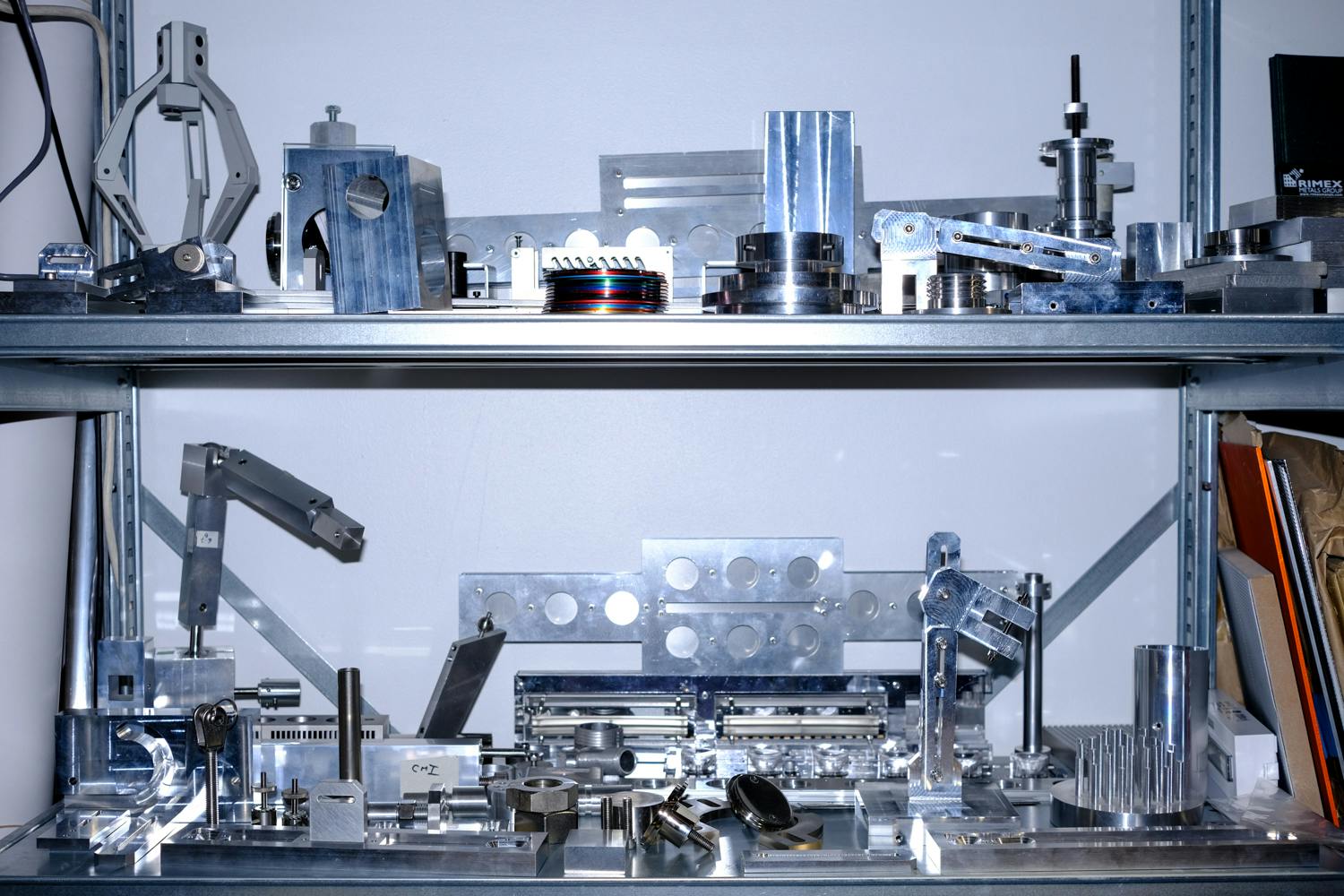



Do you think this is something you can suggest to Acne in terms of collaboration work?
Est-ce que vous pensez que c'est quelque chose que vous pouvez proposer à Acne de collaborer ainsi?
B_ All this work gave us the lamp that is right behind you. My idea was to put yellow filters everywhere on the windows and to have yellow light everywhere inside, except in the workspaces.
B_ Tout ce travail est ressorti dans la lampe qui est juste derrière vous. C'est à dire que mon idée était de mettre des filtres jaunes partout sur les vitres et d'avoir de la lumière jaune partout à l'intérieur, sauf dans les espaces de travail.
Why yellow?
Pourquoi en jaune ?
B_ The inspiration came from a film. I researched films within films. There’s this black-and-white movie about a film shoot that has to stop because they run out of money. And when they shoot this movie within the movie, all the frames are yellow. So the idea was as if we were shooting a film within a film in Floragatan and the whole building is yellow, except the work areas which are white. While that project was shelved we ended up making this light that we have here.
B_ Parce que ça me venait d'un film. J’ai fait des recherches sur les films dans les films. Il y a ce film en noir et blanc qui raconte l'histoire d'un tournage qui s'arrête parce qu'ils n’ont plus d'argent. Et quand ils tournent ce film dans le film, toutes les images sont jaunes. C'était ça ma source d'inspiration, on tourne un film dans un film aussi à Floragatan et tout le bâtiment est jaune, sauf les zones de travail qui sont en blanc. Et puis finalement, ça a été abandonné. mais c'est ressorti avec ce luminaire qu'on a à côté là.
And this is the second one you've released?
Et ça, c'est le deuxième que vous sortez ?
B_ Yes, we released it a few weeks ago.
B_ On l'a sorti déjà il y a quelques semaines.
So there is a blue one and a yellow one?
Donc il y a un bleu et un jaune ?
B_ Yes, we added the blue one yesterday.
And This is the light for the RATP.
B_ Oui, on a rajouté le bleu hier.
Et c'est ça le luminaire pour la RATP.
Regarding your work with brands like Acne and Balenciaga, how do you interpret their DNA while keeping your style? Your particular signature comes out quite clearly even as we recognise each designer’s DNA.
Concernant votre travail avec des marques comme Acne et Balenciaga, comment interprétez-vous leur ADN tout en gardant votre style ? On voit l’ADN de chaque créateur mais on perçoit toujours votre patte malgré tout.
B_ I developed my style while working with Balenciaga and it was when I finished working with them that I realised that I had developed a style over these twelve years. I hadn’t realised it before. Then I went to work for Céline.
B_ J'ai développé mon style en travaillant avec Balenciaga et c'est quand j'ai fini de travailler avec Balenciaga que je me suis rendu compte que j'avais développé un style pendant ces douze ans. Moi, je ne m'en rendais pas compte. Puis je suis allé travailler pour Céline.
You were looking for a new challenge?
Était-ce un nouveau challenge ?
B_ First, because I needed to pay the bills (laughing), then because they reached out to me. For a very long time, I wasn’t actively communicating about my work or my name at all. When we did Paris Design Week in 2020, I had people from big fashion houses come up to me and say: ‘Did you do this? We know your work, but we didn't know who had done it.’
B_ D'abord parce que j'ai besoin de manger (rire), ensuite parce qu'ils m'ont demandé. Pendant très longtemps, je n'ai pas du tout communiqué sur mon travail, sur mon nom. Quand on a fait Paris Design Week en 2020, j'ai des gens qui sont venus de grandes maisons, qui m’ont dit ‘C’est vous qui avez fait ça? Je connais votre travail, mais je ne connais pas votre nom.’
Same for me, I had seen your work, but you remained mysterious.
Pareil pour moi, j’avais vu votre travail mais vous restiez mystérieux.
B_ Cartier, for example, told me ‘We’ve known about your work for a very long time’. Acne Studios was looking for a team of architects and lighting designers to do their stores. I came with my lookbook, but they told me 'We don’t need it, we know your work very well’. They had lots of photos of my work, even some that I didn't have myself.
B_ Cartier par exemple, ils m’ont dit ‘Je connais votre travail depuis très longtemps’. Acne Studios cherchait une équipe d’architectes et d’éclairagistes pour faire leurs boutiques. Je suis venu avec mon book, mais ils m’ont dit ‘On n'en a pas besoin, on connaît très bien votre travail’. Ils avaient plein de photos de mon travail que moi-même je n'avais pas.
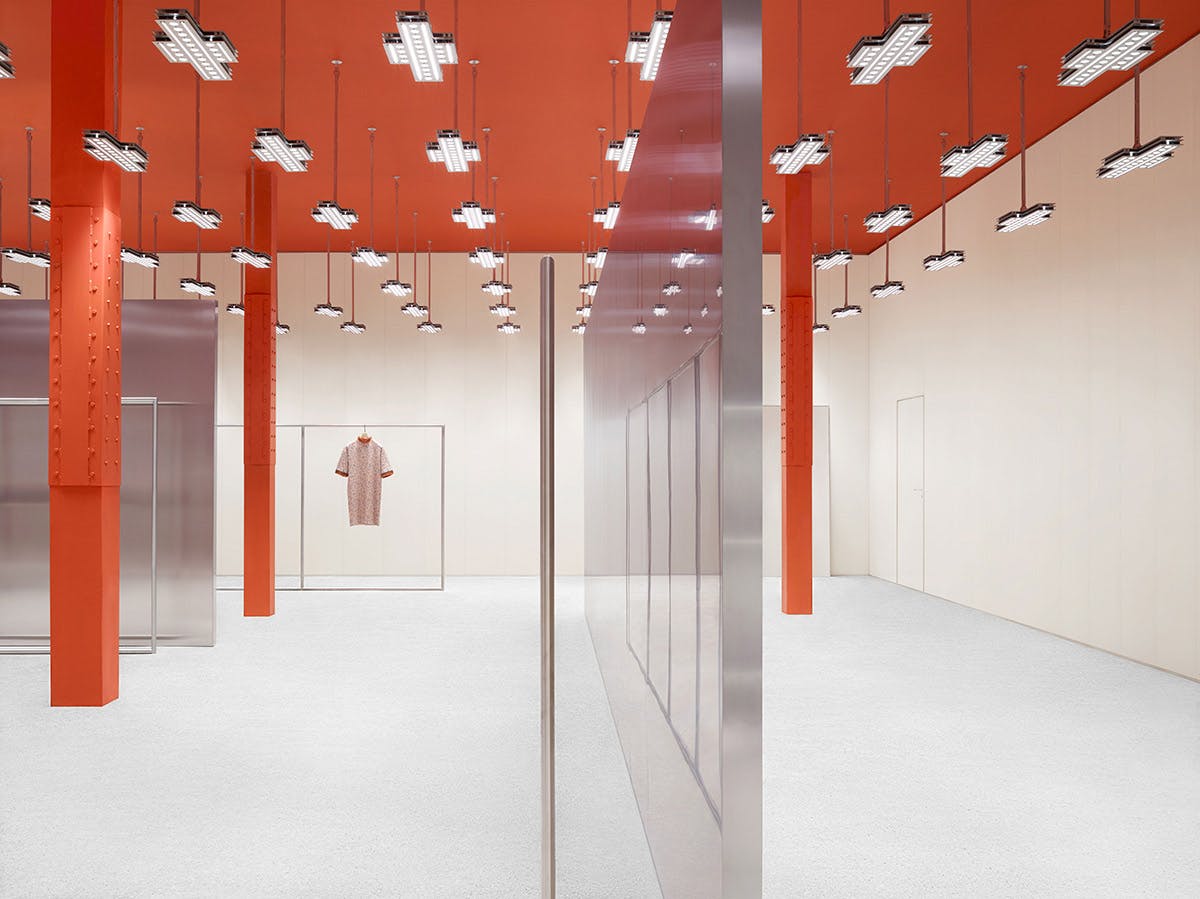
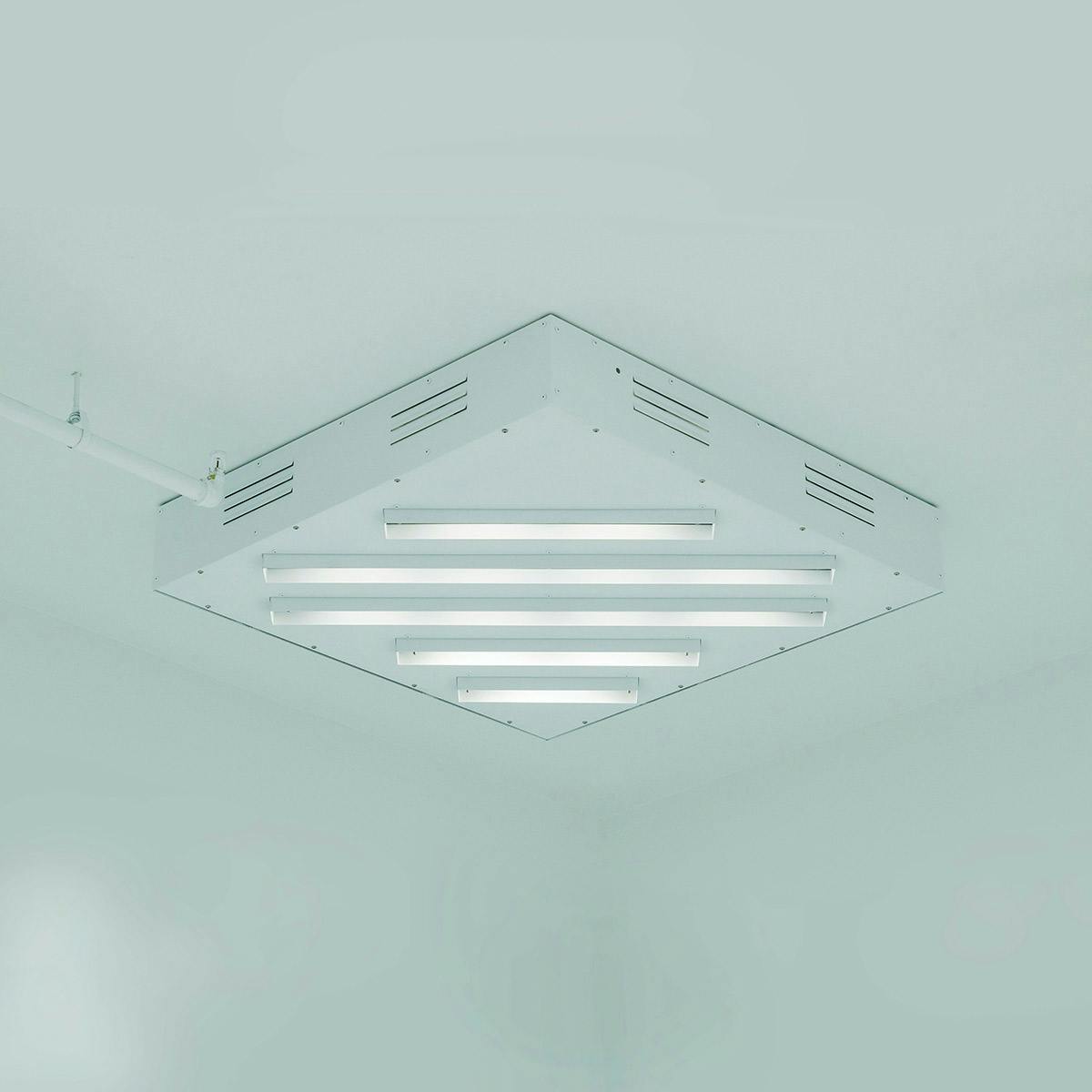
It’s such craftsmanship to create a beautiful piece of lighting that is essentially invisible while still allowing the product to stand out. How do you go about it? Because it’s a delicate balance between creating something very beautiful while putting the product forward?
C'est un tel savoir-faire que de créer une belle pièce d'éclairage qui est essentiellement invisible tout en permettant au produit de se démarquer. Comment vous y prenez-vous ? Car c’est un équilibre délicat entre créer quelque chose de très beau tout en mettant le produit en avant?
P_ For the Acne stores, they never explicitly requested something minimal. We worked with an artistic director so there was an overall concept for the whole store. They called on other artists for the furniture, for example. So the store was a designed architectural environment where the products were made to stand out through the lighting.
B_ It’s a concept of equal, very uniform light. At no time does the light tell customers ‘Look there or look there’. On the other hand, light, as it is equal, allows for the smallest objects as well as the largest, to find their full dimension in space. Clothes for me are often architectural elements and all these elements form an architectural whole. So this equal light allows each object to exist. The customer has immense freedom to go and see what they want to see, which is why I think they have a very pleasant experience. Their gaze is free to explore what they want, they make the active step of looking. It's very Japanese in spirit. This is anti-theatricality.
Because there had been this trend for putting on this heavily theatrical light or scenography in shops at the time. But I don't think there's anything artistic about that. I found it interesting to provide this equal light, which was also very sophisticated, through a choice of optics and the quality of the LEDs. It’s very very important to distinguish all the details of the various fibres...For example, for every garment that belongs to the knit category, depending on the light, you will see the specific hand of the mesh where everything disappears and you have the impression that the mesh is flat. So it is all this work on the quality of the optics, the quality of light diffusion, and the quality of the lighting, which will allow everything that is presented to be better perceived by the human eye.
There is also this work that we are doing here on the quality of the light displayed. You have colours and types of leather that are very similar, and if you don't have a very rich light, you won't see the colour difference. When we worked on the Balenciaga store in Los Angeles, Nathalie Marek, who was head of display, had a pair of red shoes to present. She told me very kindly that there was a big issue with the colour. So, we worked specifically to improve that. There’s always a risk in what we do, the risk of missing things all the time. We have a project coming up with Acne. They are going to install a new model of blown glass lighting that we designed. It kept me up all night because I was thinking to myself: ’We haven’t had the time to test the lenses we received, we haven’t put them on the prototype to see if they fit’.
P_ Pour les boutiques Acne, ça n'a jamais été une demande de ne pas être trop présent. À chaque fois on a travaillé avec la direction artistique et il y avait un concept global pour toute la boutique. Ils faisaient appel à d'autres artistes pour le mobilier par exemple. Donc toute la boutique était un environnement architectural pensé où les produits étaient mis en valeur par la lumière.
B_ C’est un concept de lumière égale, très uniforme. À aucun moment la lumière dit aux clients ‘Regarde là ou regarde là’. Par contre, la lumière, comme elle est égale, elle permet aux plus petits objets comme aux plus grands, de trouver toute leur dimension dans l'espace. En fait, les vêtements pour moi sont souvent des éléments d'architecture et tous ces éléments rentrent dans une globalité architecturale. Donc cette lumière égale permet à chaque objet d'exister. Le client a une immense liberté d'aller voir ce qu'il a envie de voir, raison pour laquelle je pense qu'il a une expérience qui est très agréable. Son regard est libre de se poser sur ce qui l'intéresse, c'est lui qui fait la démarche de regarder. C'est très japonais dans l'esprit. C’est l'anti-théâtralité.
Parce qu'il y a quand même eu cette mode incroyable de mettre une lumière théâtralisée ou scénographiée dans les magasins. Mais je trouve que ça n'a rien d'artistique. Je trouvais ça intéressant de mettre une lumière égale, mais aussi très travaillée, avec un choix d’optiques et la qualité des puces LED. C'est très très important pour distinguer tout le détail des fibres…Par exemple, tout ce qui est ce qu'on appelle les mailles, en fonction de la lumière, vous allez voir le relief de la maille où tout va disparaître et vous avez l'impression que la maille est plate. Donc c'est tout ce travail sur la qualité des optiques, la qualité de diffusion de la lumière, la qualité de la lumière, qui va permettre à tout ce qui est présenté d'être mieux perçu par l'œil humain.
Il y a aussi ce travail que l'on fait ici sur la qualité de la lumière à restituer. Vous avez des couleurs, des cuirs qui sont très proches, et si vous n'avez pas une lumière très riche, vous ne voyez pas la différence de couleur. Quand on a fait le magasin pour Balenciaga à Los Angeles, Nathalie Marek, qui faisait le display à l'ouverture des boutiques, avait une paire de chaussures rouges à présenter. Elle me dit très gentiment qu'il y a un gros problème de couleur. Du coup, on a travaillé pour améliorer ce sujet. Il y a toujours dans ce qu'on fait une prise de risque, le risque de rater les choses tout le temps. On a un projet pour Acne cet après-midi. Ils vont installer un nouveau modèle de luminaires en verre soufflé qu'on a dessiné. Moi, ça m'a réveillé cette nuit parce que je me suis dit :’On n'a pas testé les platines qu'on a reçues, on ne les a pas mises sur le prototype pour voir si ça collait’.
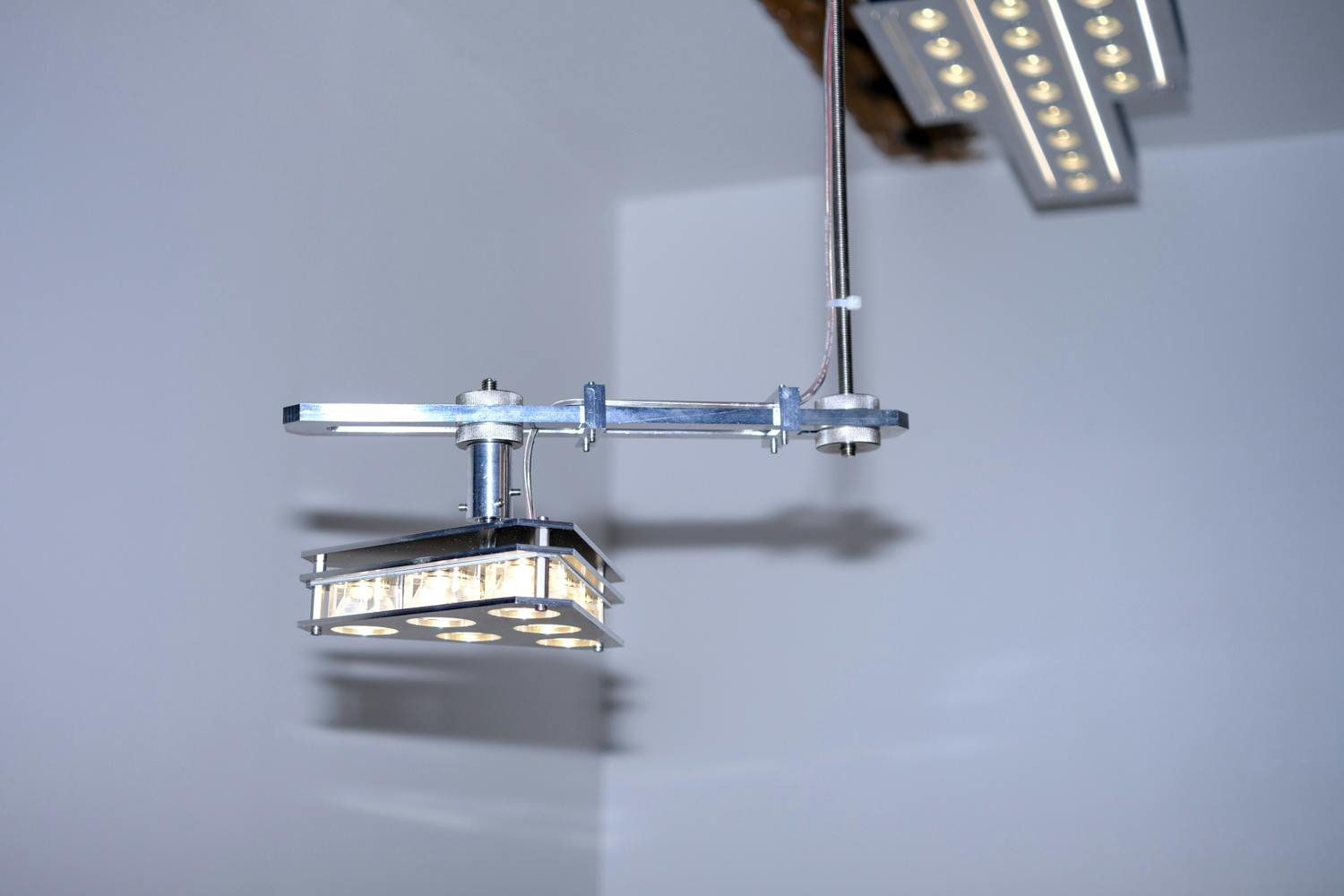
Do you do residential projects?
Est-ce que vous faites des projets résidentiels ?
B_ That’s not something I know how to do. Because first of all, the people I speak to tend to have a very different culture. We would have to work side by side with an artistic director or an architect and start working together on the project very early on. Because you have seen that with light, I can transform the perception of colours, I can transform the perception of spaces. I have a say in all of that.
P_ Even when you work on a store, there’s the whole installation of the object, how to think about the light going through that space. It's not just about drawing an object.
B_ And then we need to be inspired by what the architect or artistic director draws. We have to be excited about the project. I like collaborations with artistic directors, the person I work with needs to have a creative vision. And I come in to complement his vision.
And we still have a lot of requests that we have to turn down. Today, I can choose what I want to work on. This was not the case in the past. This freedom is great.
B_ J’en suis incapable? Parce que d'abord les gens qui s'adressent à moi, c'est des gens qui ont vraiment une culture très différente. Il faudrait vraiment travailler avec un directeur artistique ou un architecte dont je partage vraiment le travail, et commencer à travailler ensemble très tôt dans le projet. Parce que vous avez vu qu'avec la lumière, je peux transformer la perception des couleurs, je peux transformer la perception des espaces. Je maîtrise tout ça.
P_ Même quand on fait les boutiques, il y a toute l'installation de l'objet, comment penser la lumière sur tout l'espace. Ce n'est pas juste dessiner un objet.
B_ Et puis il faut que ce que dessine l'architecte ou le directeur artistique nous inspire. Il faut qu'on soit excités par le projet. J'aime bien les collaborations avec des directeurs artistiques, des gens créatifs, mais il faut que la personne avec qui je travaille ait une vision. Et là, je peux répondre à cette vision.
Et on a quand même pas mal de demandes qu'on refuse. Maintenant, j'ai la possibilité de choisir. Ce n'était pas le cas par le passé. Cette liberté-là est énorme.
How do you approach visual comfort with what you design? Because it’s very important to have a feeling for a space.
Comment abordez-vous le confort visuel avec ce que vous concevez ? Car c'est très important d'avoir un ressenti dans un espace.
B_ It’s fundamental. This is all work on colour perception. I burned my eyes several times while experimenting with UV lamps. And I spent many days of my life being blind, like mountain climbers. It was a long time ago, in 1993, 1994. But I’ve remained very sensitive to light and the slightest source of light, that is a little dazzling, bothers me. And I understood that, when a point of light disturbs you, you have a hard time with the overall visual perception. And this visual perception evolves with age. The people I work with are younger than me and see more things than I see. Even though thanks to my experience I can still get certain things. These experiences made me hypersensitive to light. This is called photophobia. A point that is too dazzling immediately reminds me of my trauma and so I tend to look for that extreme comfort in all my projects. So there are international scientific units of measurement to describe this visual comfort, it's called UGR (Unified Glare Rating). I discovered this not too long ago. Until then, I was playing it by ear. So I'm very careful that my projects aren't dazzling. As soon as I see a dazzling spot, I tend to leave. For me, it's bad, immediately, no respect.
B_ C’est fondamental. C'est tout le travail sur la perception des couleurs. Je me suis brûlé les yeux plusieurs fois en faisant des expériences avec des lampes UV. Et j'ai passé plusieurs jours de ma vie aveugle, comme les alpinistes. C’était il y a longtemps de ça, en 1993, 1994. Donc je suis resté très sensible à la lumière et la moindre source de lumière, qui est un peu éblouissante, me dérange. Et donc j'ai compris qu'en fait, quand un point lumineux vous dérange, vous avez une difficulté de perception visuelle. Et cette perception visuelle évolue avec le temps, avec l'âge. Donc par exemple, les gens avec qui je travaille sont plus jeunes que moi, voient plus de choses que je n'en vois. Après ça, l'expérience fait que je me doute de certaines choses. Ces expériences m'ont rendu hypersensible à la lumière. On appelle ça la photophobie. Un point trop éblouissant me rappelle tout de suite mon traumatisme et donc j'essaie dans tous mes projets d'être extrêmement confortable. Alors il y a des unités de mesures scientifiques internationales pour décrire ce confort visuel, ça s'appelle UGR (Unified Glare Rating). J'ai découvert ça il n'y a pas très longtemps. Jusque là, je faisais au doigt mouillé. Donc je fais très attention à ce que mes projets ne soient pas éblouissants.
Et après ça, dès que je vois un point éblouissant, je m'en vais. Pour moi, c'est mauvais, immédiatement, sans respect.

